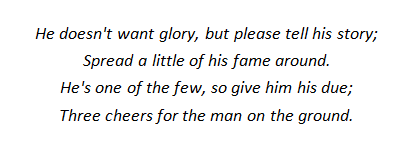 |
Clem left NSW on 5 August 1943 via No.2 Embarkation Depot (2 ED) at Bradfield Park on Sydney Harbour and arrived back in Australia at the beginning of January 1945. For 14 months he kept a diary which describes his journey and tour of operational service in the islands north of Australia.
His last diary entry was dated 30 October 1944, two months before he completed his overseas service. His diary is very insightful about the time he spent at Milne Bay, Goodenough Island, Kiriwina (all parts of Papua New Guinea), and Noemfoor Island (Dutch New Guinea).
I believe unrecorded activities include a move to Morotai in the Halmahera Islands (Indonesia) and a return to Noemfoor Island three weeks later. More interestingly, Chris Noonan [Ref 4] is certain that on at least two occasions, Clem flew on operational missions as a (tail) gunner with 22 Squadron in Douglas Boston medium bombers. While this is not supported by the diary, the diary does document how much machine gun practice Clem had had and that he was a very good shot. As such he would have been a good candidate to step in if a regular air gunner was unavailable.
His complete diary is provided below. It provides a unique insight into the character of the man and his personal reactions to the horrors of war. I have inserted restored copies of his photographs (taken during the time he wrote the diary) within the text. I’ve presented the photographs at points of my own choosing as only one photo records even the month of the year it was taken. His photos show the exotic features of the places he lived and the people he met along the way. His photographs bring the text of the diary to life.
Note on photographs:
It is possible that some of Clem’s photographs are copies handed out by the RAAF at the places he was stationed. One example of this is the photo of crashed RAAF 75 Squadron Kittyhawk A29-73 at Milne-Bay in 1943 (shown below). Other photos in Clem’s collection appear to have been taken on a personal camera. On 25 September 2014 Chris Noonan explained that Clem had secreted a tiny camera away with him to war. “This camera might have only contained one roll of film for the whole war, and was small enough to fit into a tobacco tin. It was not exactly legal to have a camera away with you…..” Chris does not know the eventual fate of this camera.
– 1 –
CORPORAL NOONAN C.G. Service no. 21202
75 SQUADRON
22 SQUADRON
Posted no.2 E.D.19/7/43.
Arrived Bradfield 28/7/43. Left 5/8/43.
Arrived Sandgate Brisbane 6/8/43. Left 7/8/43
Arrived Townsville 9/8/43. So far 1472. At 1 RPP. Doing commando training as far as possible. Figure offence is the best means of defence. Shirley will never understand that though. Have done Owen and Thompson guns so far.
Have looked Townsville over 15/8/43.
Out on the range with Thompson sub machine gun today 17/8/43. Prefer the Owen.
Posted to 75 Squadron 14/8/43.
Embarked Townsville (via Cairns). S.S.Ankui 23/8/43.
Landed Milne Bay 28/8/43. Placed in servicing party. It’s the second biggest rainfall in the world here. This is Papua although generally referred to as New Guinea area.
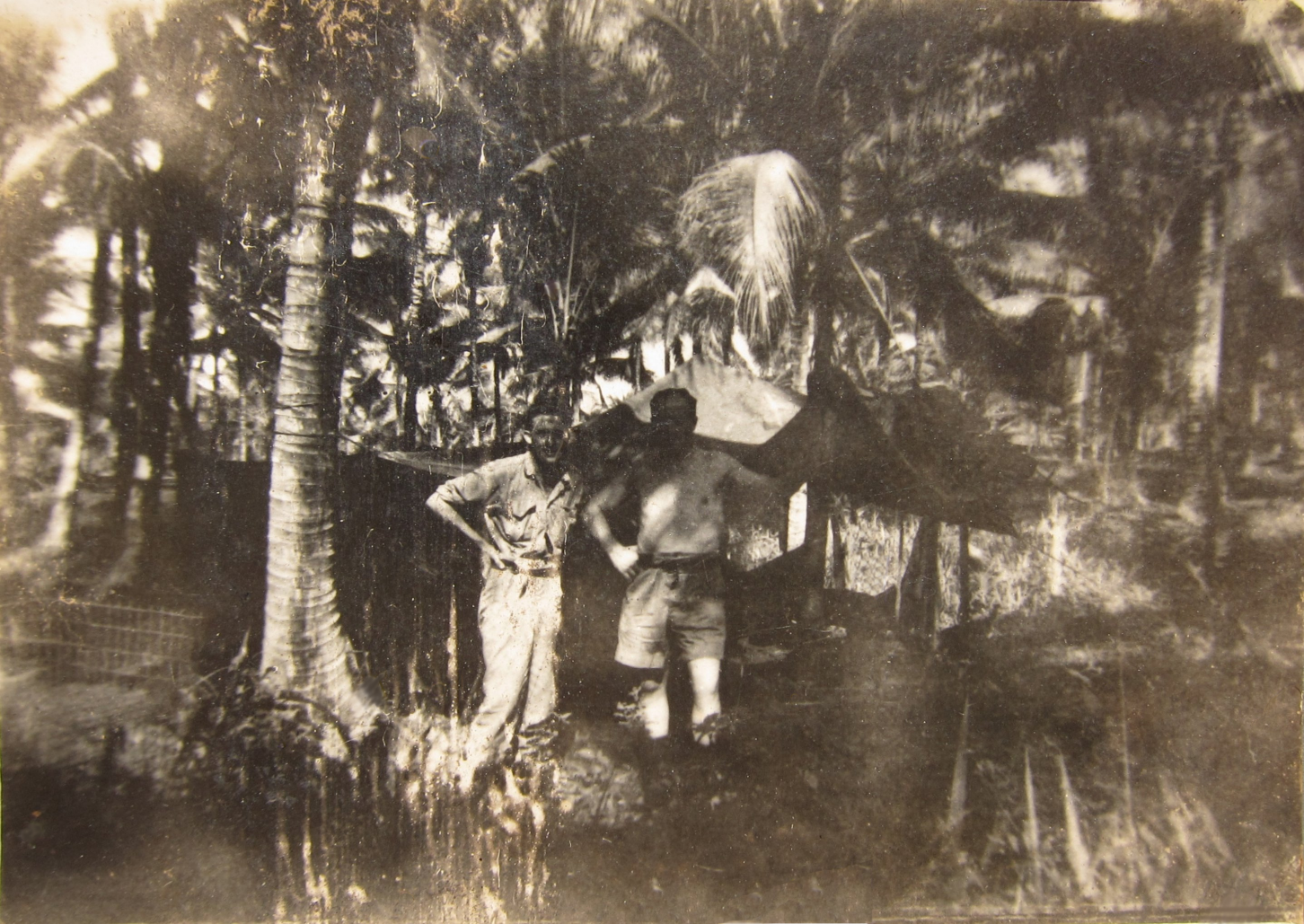 |
|
| Clem Noonan (L) and Dick Knight (R). |
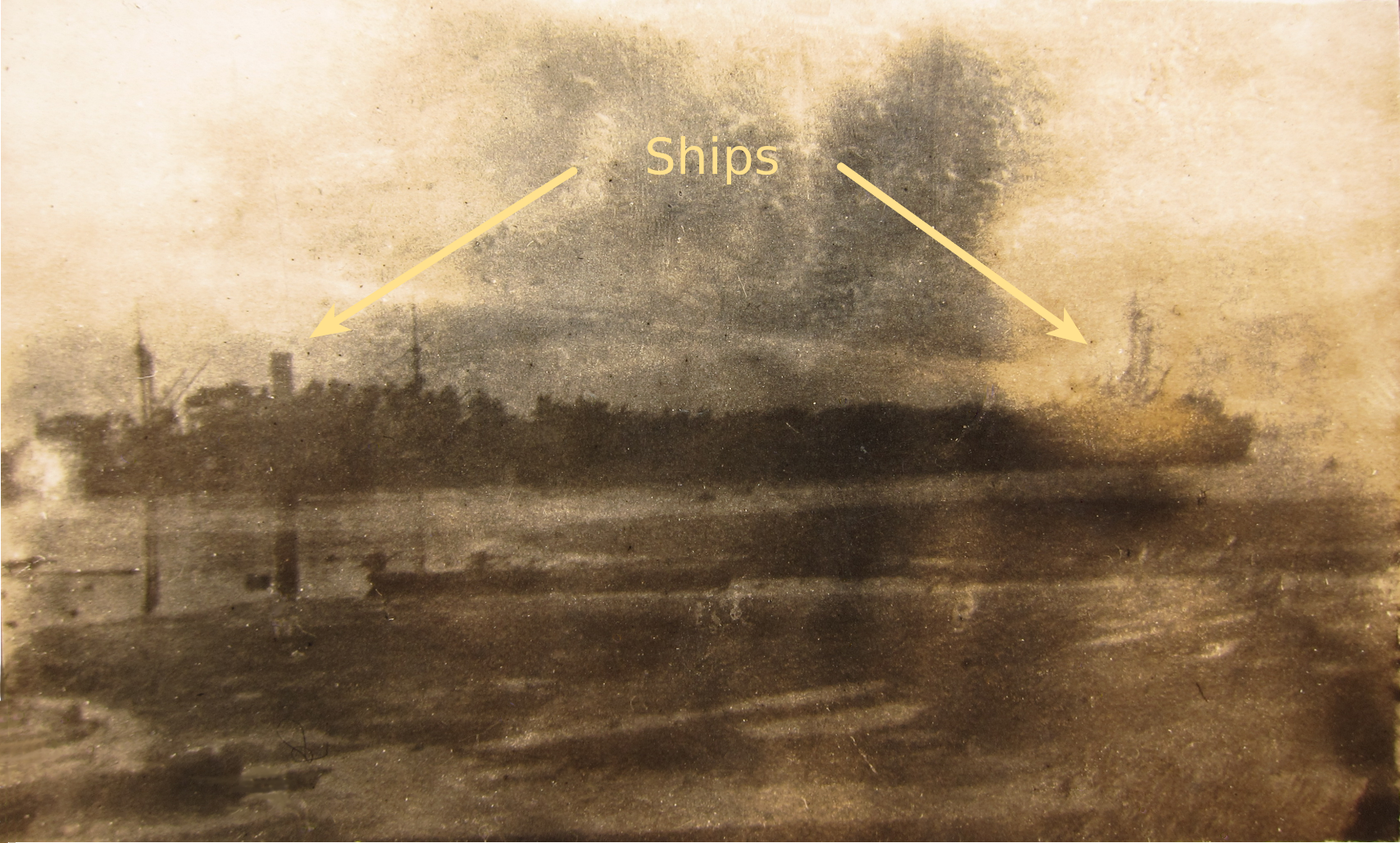 |
 |
 |
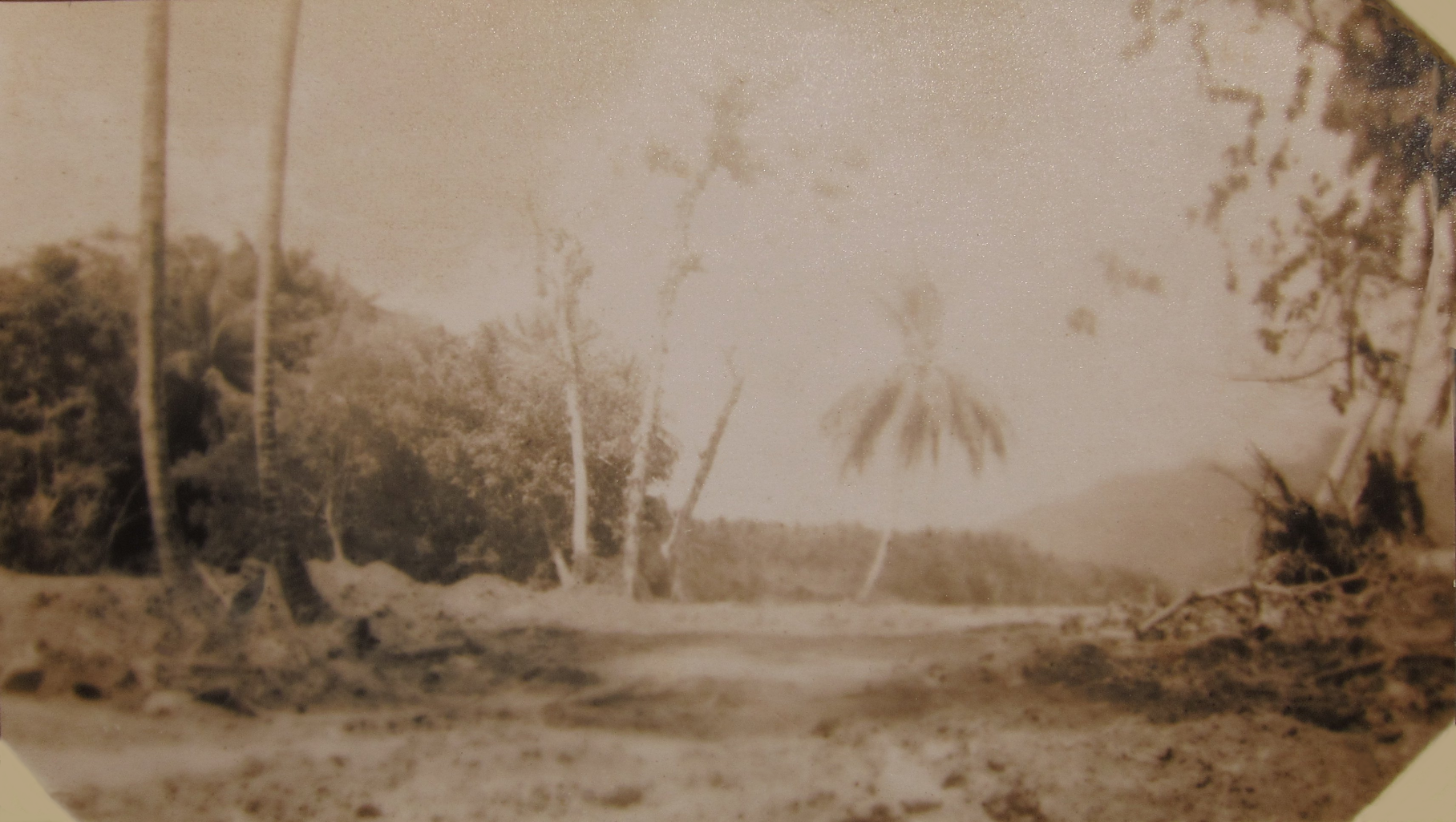 |
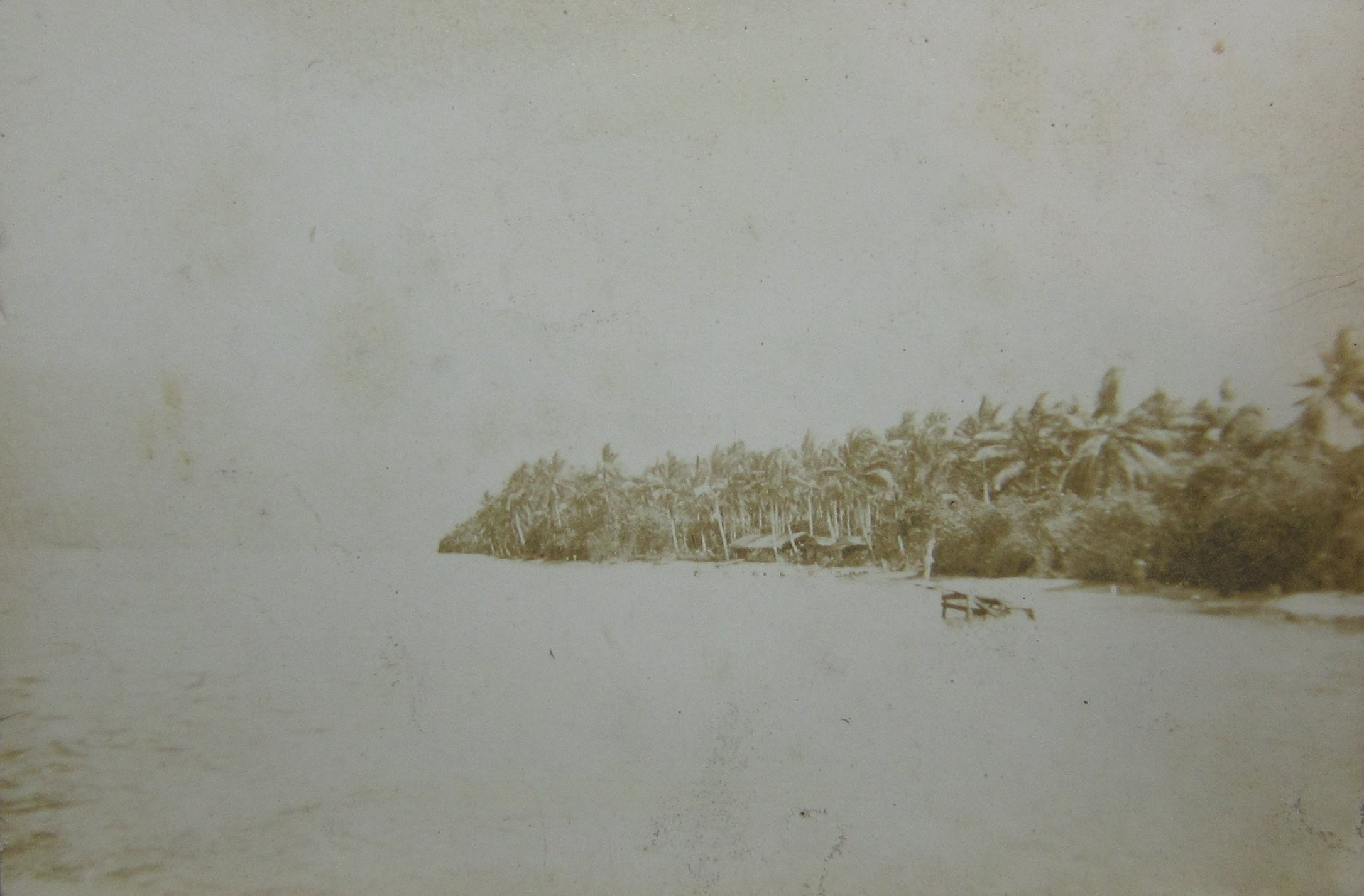 |

Had raid last night. 5/10/43 First warning was ack ack at Kiriwina 30 minutes later decoy plane arrived. Keith (see photograph at 20/11/43) Mitch and I beat 3rd wave of bombers by 5 seconds to trench. 60 bombs dropped in 1 1/2 hours raid. 6 yanks killed at Kiriwina. . Remember saying prayer that Shirley and Colleen would be alright if I was killed.
Tokyo radio told us today 6/10/43 that Australian blood would run in the Kunai grass very soon on Goodenough.
-2-
 |

9/10/43 Another raid last night. Knocked out a tanker and 2 Beauforts. Went into a trench as Japs dived. Two more alerts tonight again. Jap kites hanging about the island, no bombs this time. When bombs hit tanker direct last night, large fire started. In middle of writing to Shirley tonight had to go to trench twice.
11/10/43 Boston crashed today. Exploded 800lb bomb and burnt completely also burnt pilot to death. A bad show.
[22 (Boston) Sqn were operating from Vivigani strip on Goodenough Island at the time Clem was there with 75 Sqn. www.raafdb.com states that Knights “aircraft crashed on take off from Vivigani after the nose wheel collapsed. The aircraft skidded along the runway before hitting a ditch and flipping over, causing a fire in the bomb bay. Two crew members survived.”]
12/10/43 Out of bed into the trench again this morning 5.3Oam, Japs active again.
 |
| Click on the above image to reveal a colour photo of a similar scene. |
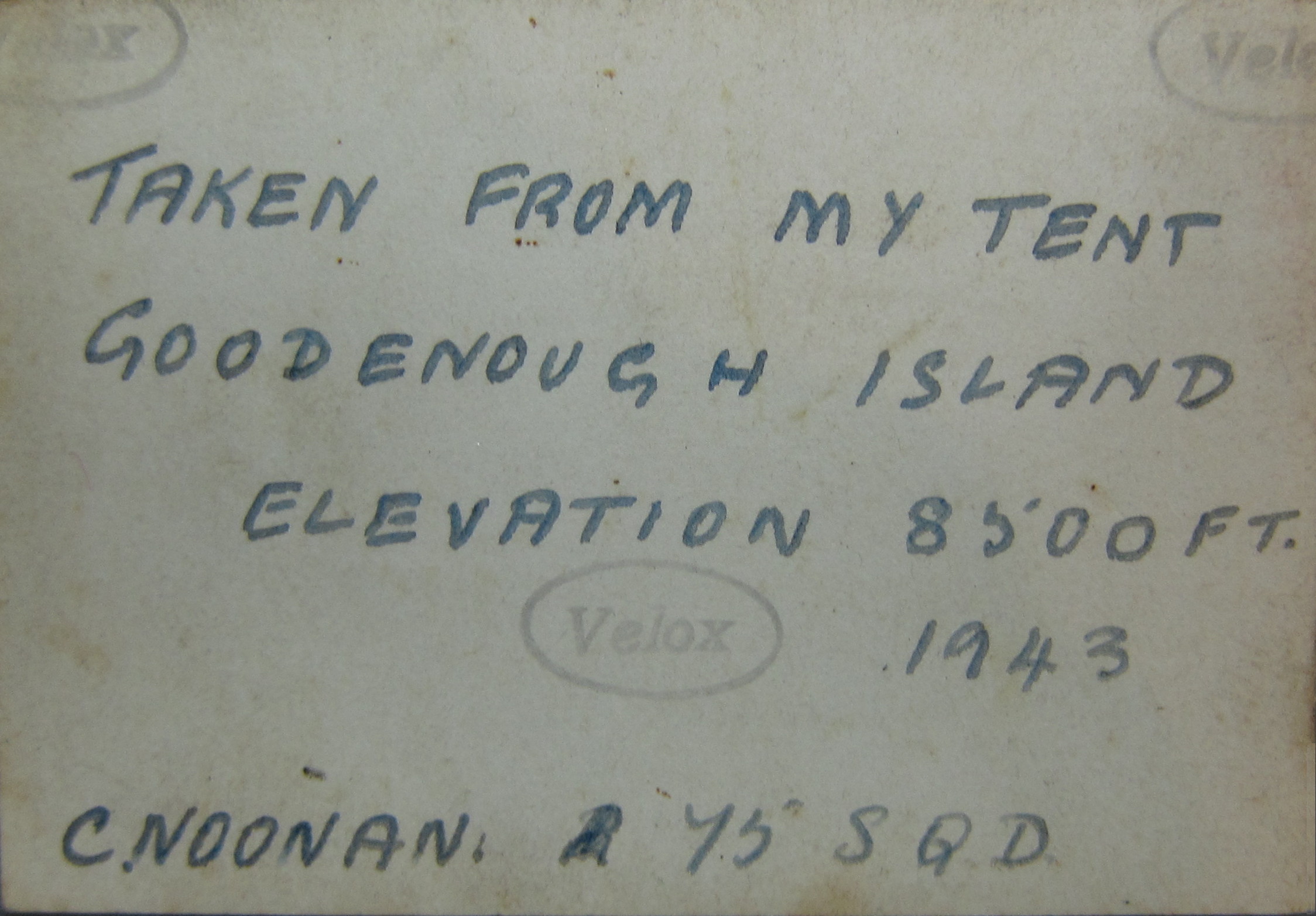
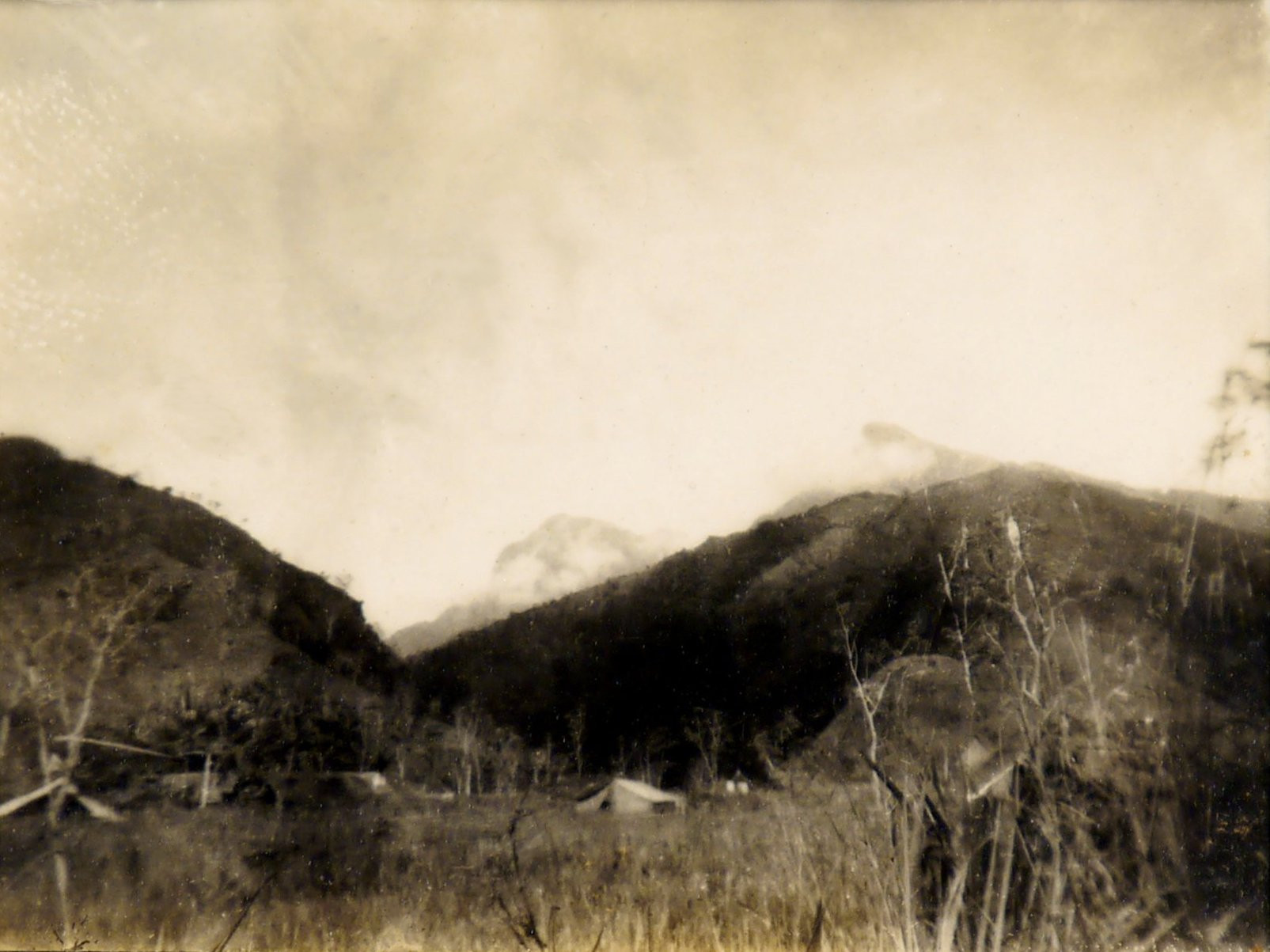 |
15/10/43 3 alerts in last few days. Out of bed into trench l.3Oam the other day or rather night. Raid today. Cappy and I went into jungle to keep away from dispersal bays. Our planes belted New Britain 389000lbs bombs dropped. Should be more of it. The full moon is the danger. We often wish during a raid that we could shoot out the moon. We’ve cut our section out of solid rock. The work of setting up and digging in was back breaking.
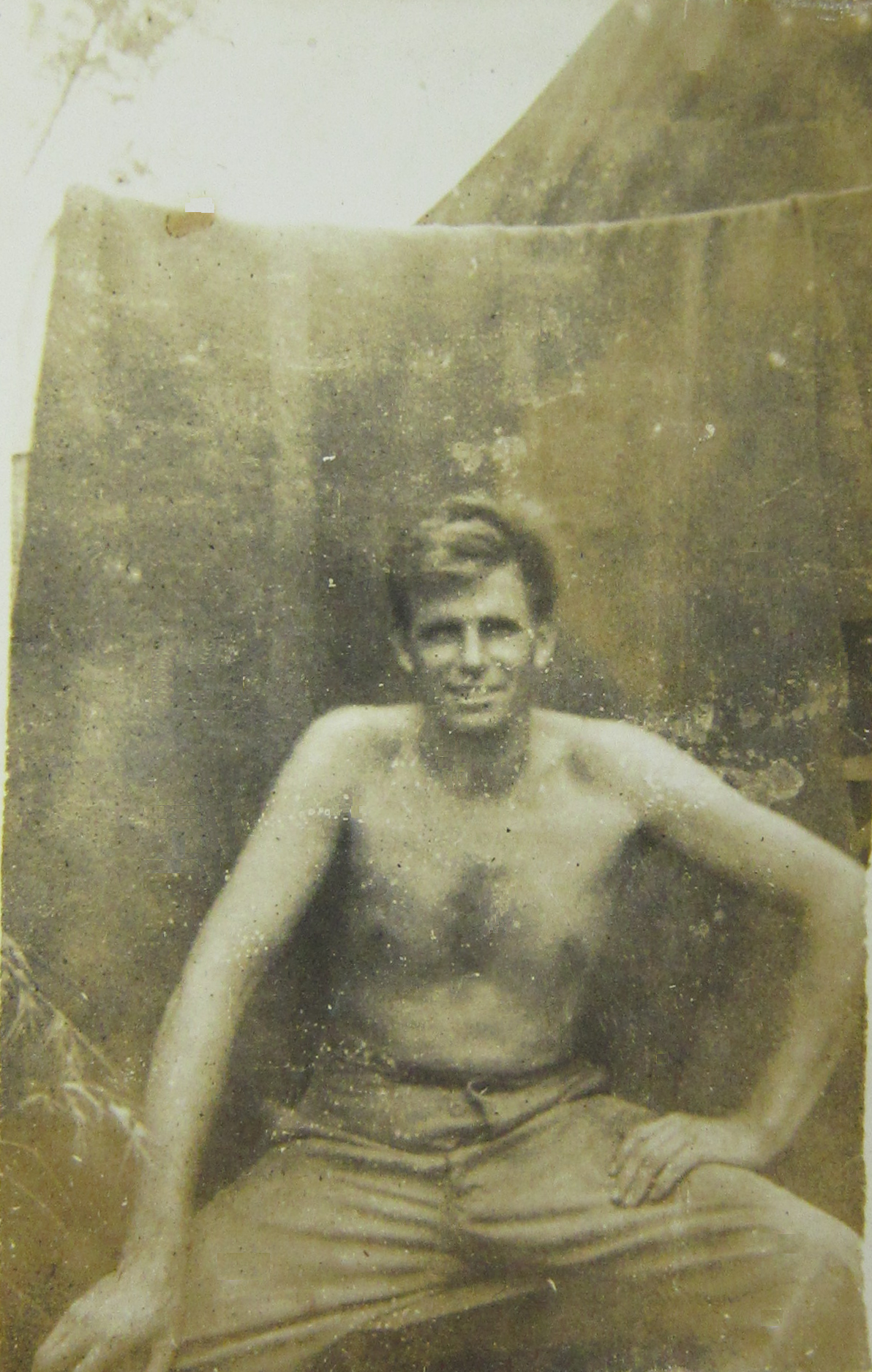 |
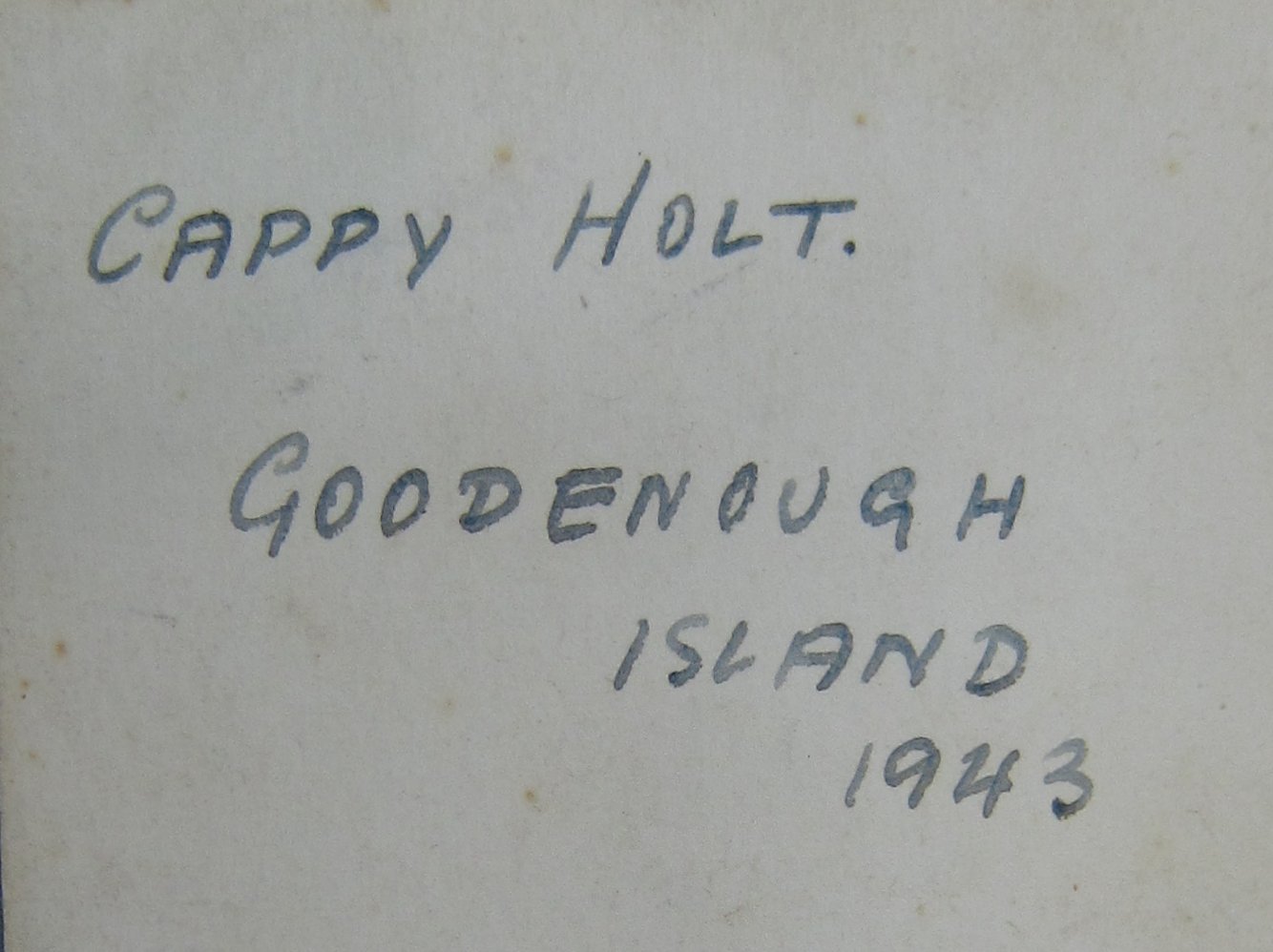
23/10/43 A zero sneaked in this morning and had a go at us.
24/10/43 Lost 4 kites last night. Paul Whitehead was tragically killed, I was very sorry over it.
26/10/43 A raid on 5.4Oam. Into trench half asleep. Kiriwina got nasty raid from Japs this morning. Several of our chaps killed. Looks like more to come yet. We’ve had several daylight raids lately, getting too hot.
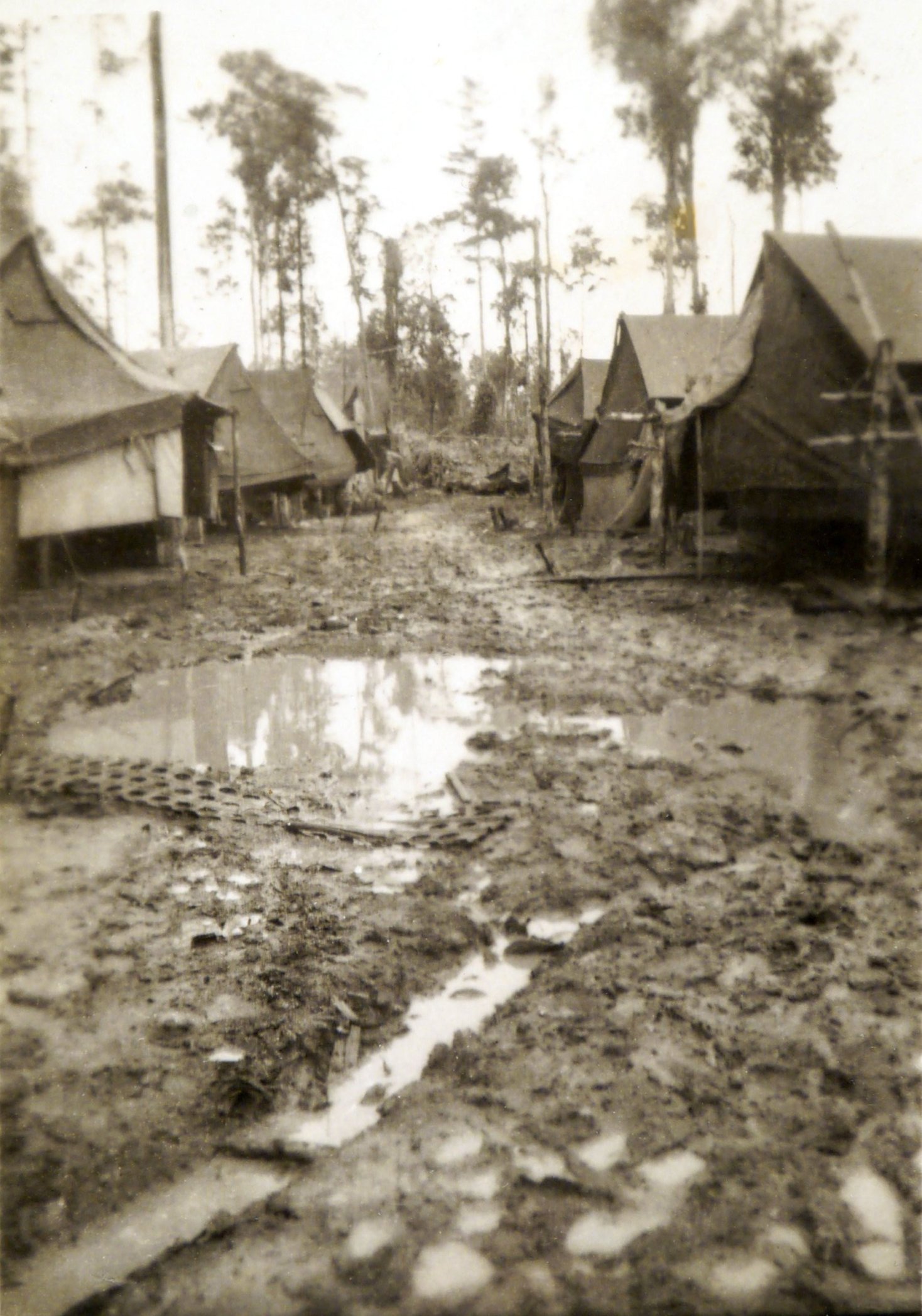 |

29/10/43 A Jap kite in again yesterday morning and he dropped a parachute into the bay. The Jap bombers were so close overhead one night you could hear the bomb racks click open and the Jap pilots talking to each other on our wave length.
20/11/43 Several more Jap Recco’s over.
 |
| Kieth Longmuir (L) and Clem Noonan (R, with cigarette). |
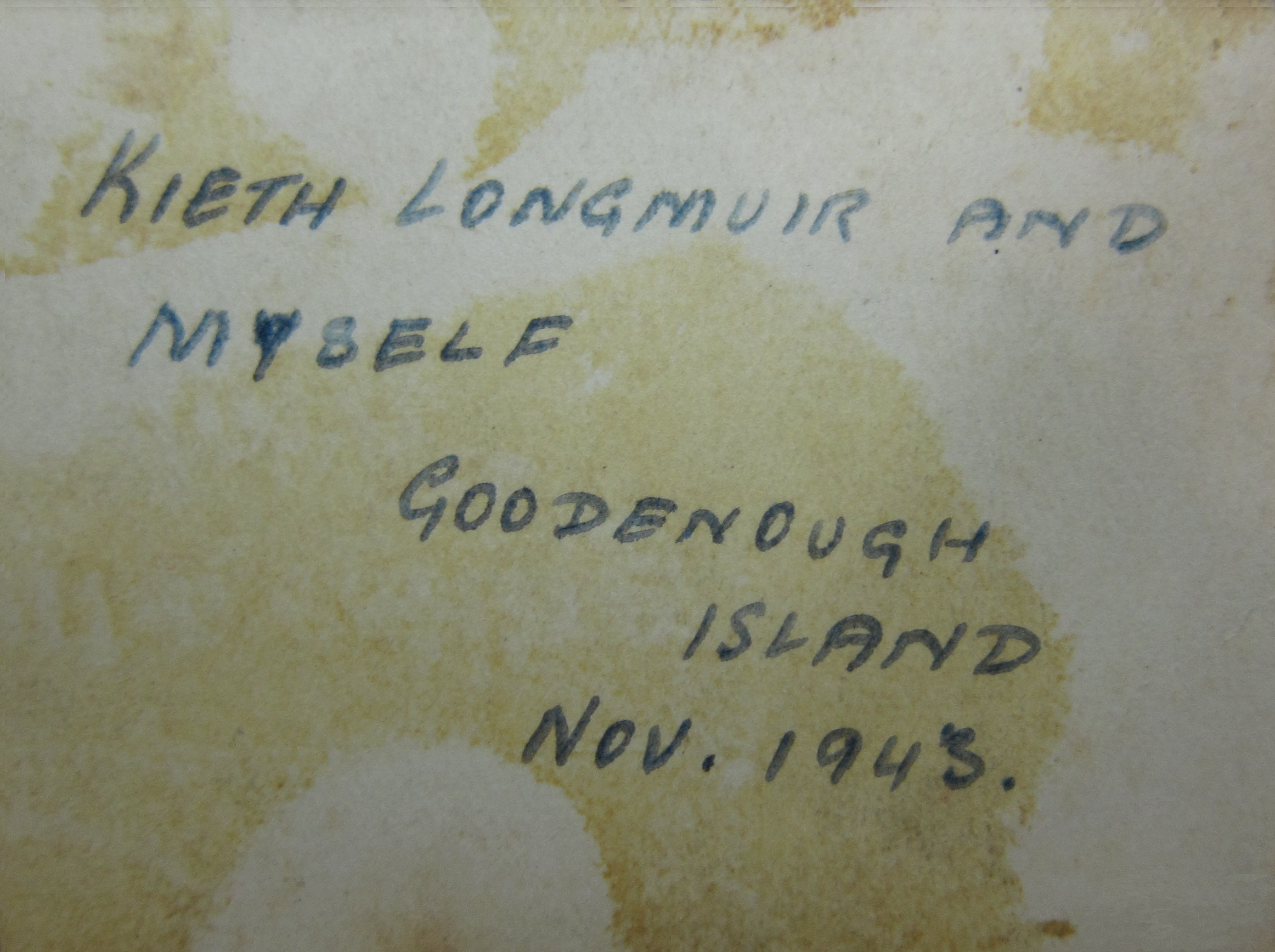
29/11/43 More Japs today. Posted to No.22 Squadron today in the Trobriand islands. The Japs will be here in force tomorrow I believe but we’re ready.
30/11/43 Still on deck.
On 5 December 1943 Clem wrote the first of three personal letters to his daughter, Colleen. This letter has survived the passage of time in excellent condition. It reads of loving tenderness. Letters to and from home provided a way for Clem and his companions to remain connected to the world of ‘normality’ even though surrounded constantly by the dangers of war. As the only known written correspondence by Clem in all of WW2 these letters are genuine treasures. There is no mention of Christmas in this letter so it is possible that Clem wrote home again within the next few weeks.
Note that the stamp has been removed from the envelope and that it bears the wartime censor’s stamp and signature. There is no way of knowing if this envelope and letter correspond.
The letter above refers to a grass bag woven by the natives of Goodenough Island for Colleen. Remarkably this bag (71 years old at the time of the photograph on 1 January, 2015) has survived in excellent condition. It can be seen below.
Other gifts for Colleen are illustrated further below.
11/12/43 Went to Little Goodenough today.
12/12/43 Had first cup of tea for 2 months today.
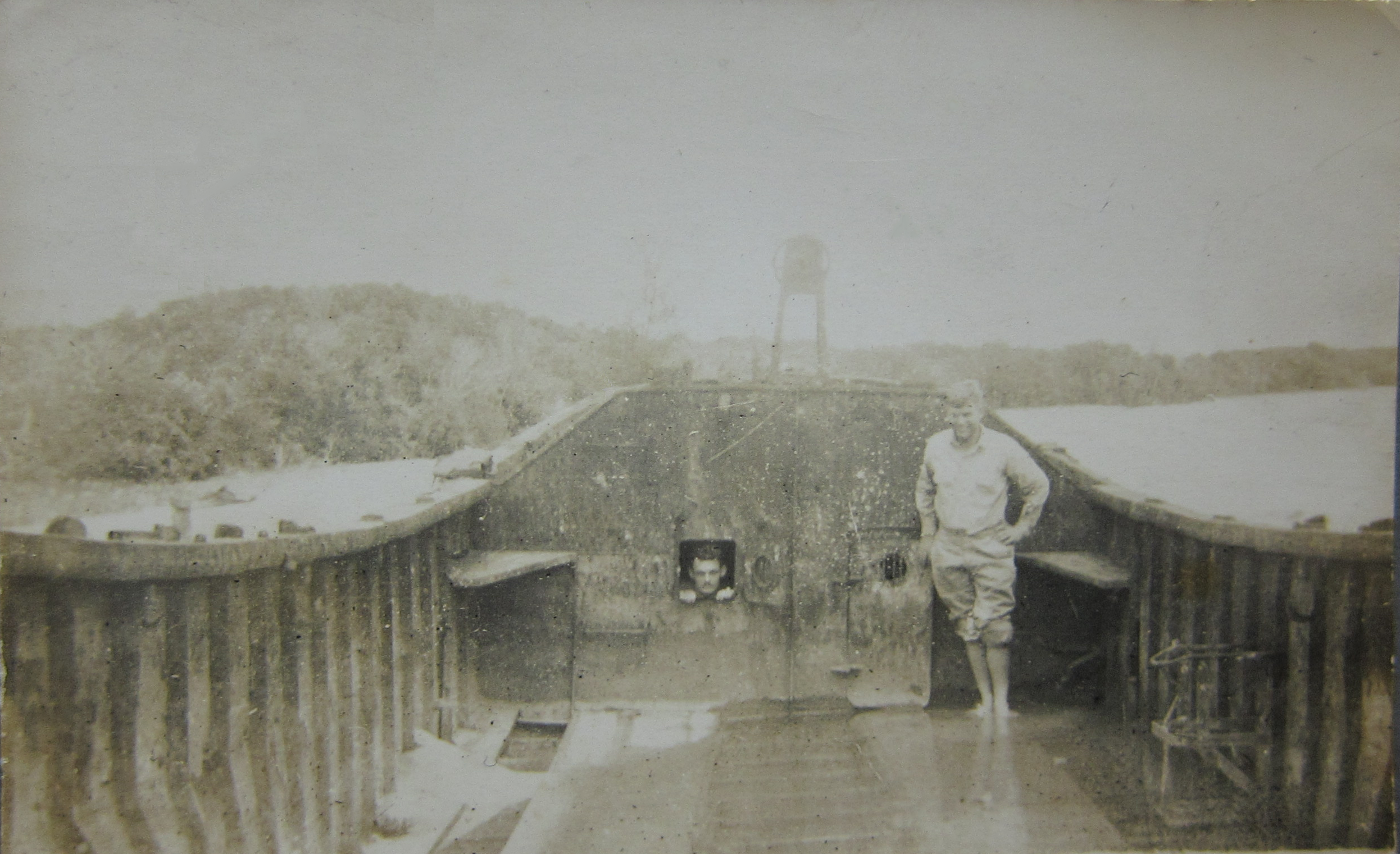 |
 |
14/12/43 The Japs bombed and machine gunned us last at 2am. I heard the first burst of gunfire right overhead about 100 feet up and did I run for my slitty. 4 of our chaps killed.
-3-
20/12/43 Japs dropped 480 small bombs on us last night. One burst of shrapnel came into my trench, another 11 feet away. They were moving too, enough to kill you instantly if you were struck. 8 casualties all told. There were 38 bombers all together and we bagged 3.
 |
| Click on the above image to see the original colour scheme of this borrowed USAAF Lockheed Lightning. |
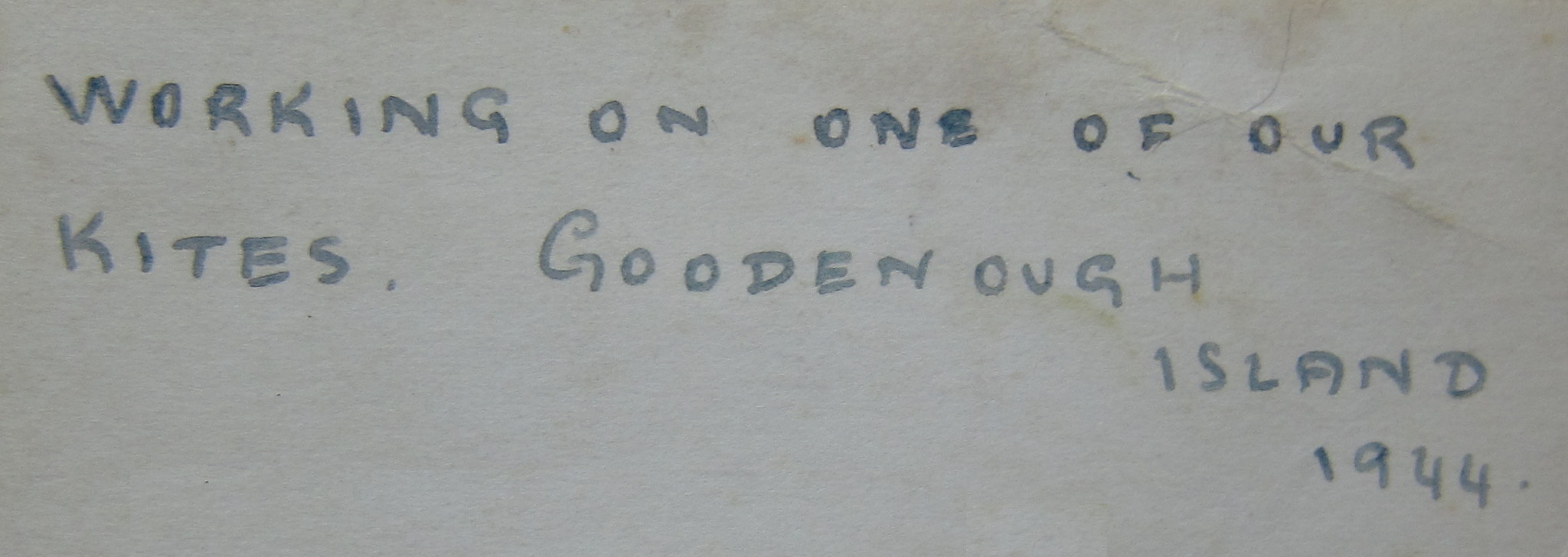
28/12/43 Arrived Kiriwina today by Avro Anson. Landed at Loshua (Losuis). In service party 22 Squadron. Coming over in the Anson I named “Shirley Island”(between D’entrecasteaux islands and Trobriand group), as the beautiful blue water reminded me of her.
NOTE: The “Shirley Island” area, Milne Bay, Goodenough Island and Kiriwina Island can be seen in the following diagram.
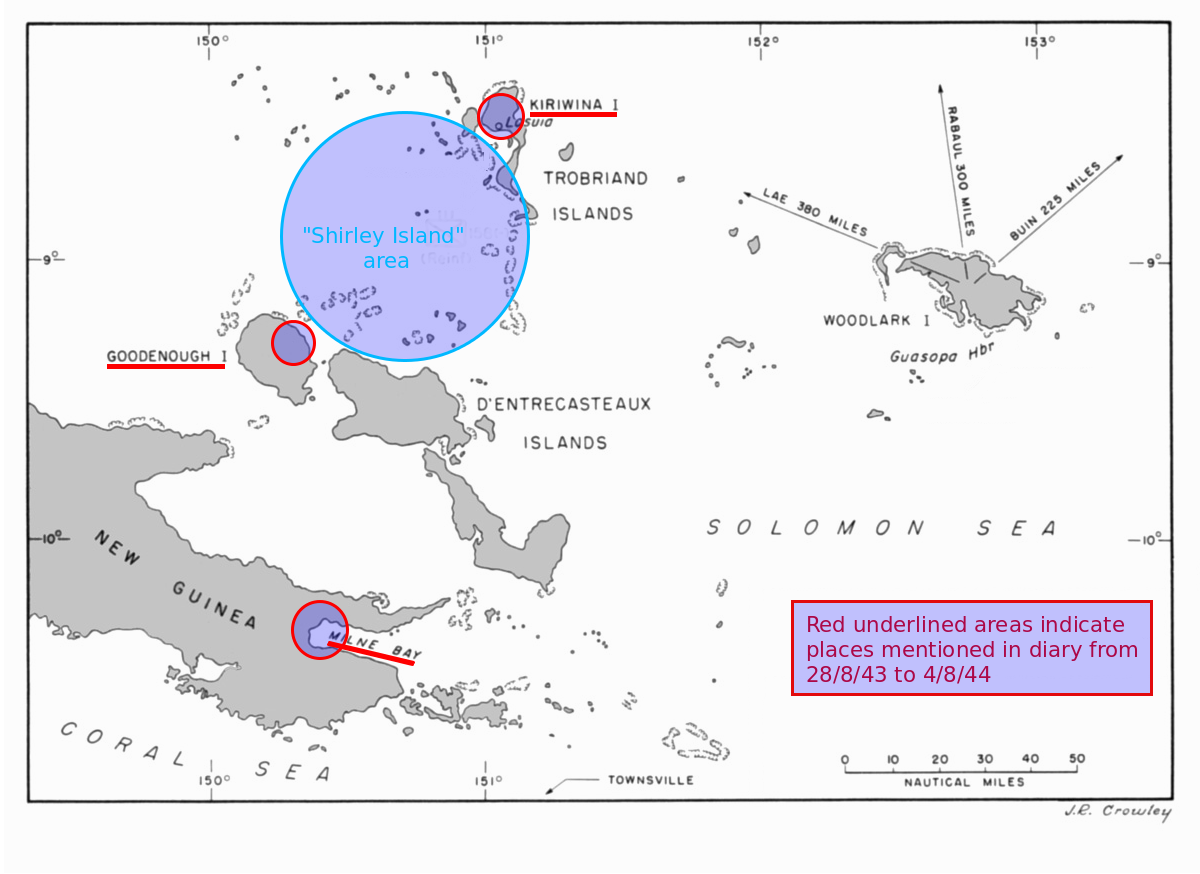
NOTE: 22 Sqn had been operating from Kiriwina since 2 Nov 1943 after moving from Vivigani strip on Goodenough Island.
NOTE: A restored Avro Anson (similar to that in which Clem made the move to Kiriwina) can be seen in the photo below.
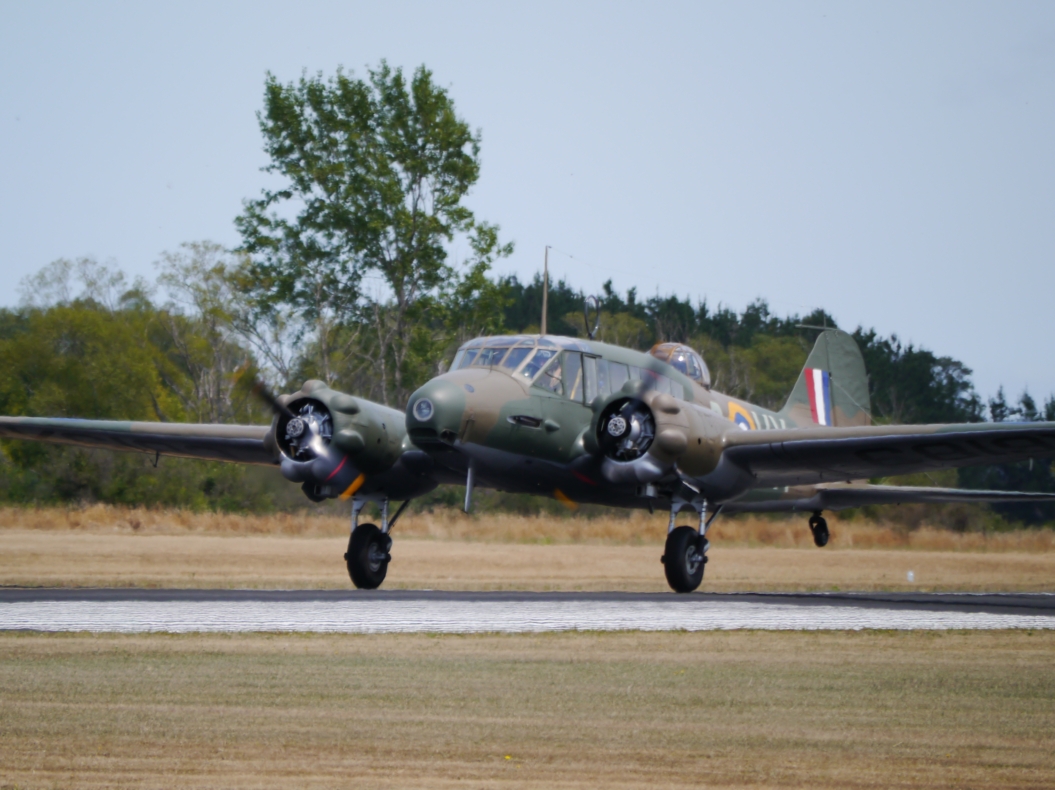
 |

Clem wrote to his only child (at that time) Colleen again on 28 January 1944. As there is no mention of the previous Christmas, this may not be the first correspondence home in 1944. This letter was written on Kiriwina (Island) two days before the birth of his first son (George) Michael. This letter is also in excellent condition.
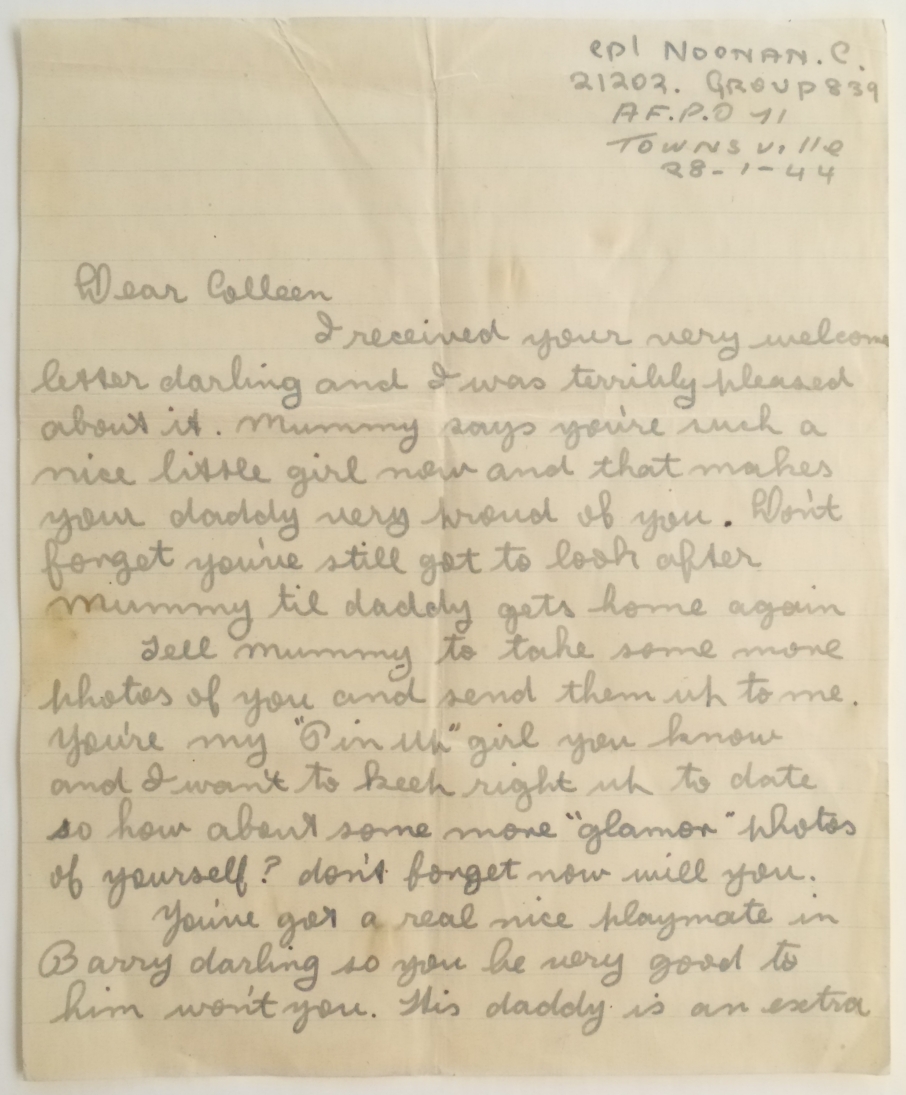 |
 |
[By February 1944 the ‘New Lambton Send-off and Welcome Home Committee’ had arranged for an enlistment presentation to be made to Clem and several others.]
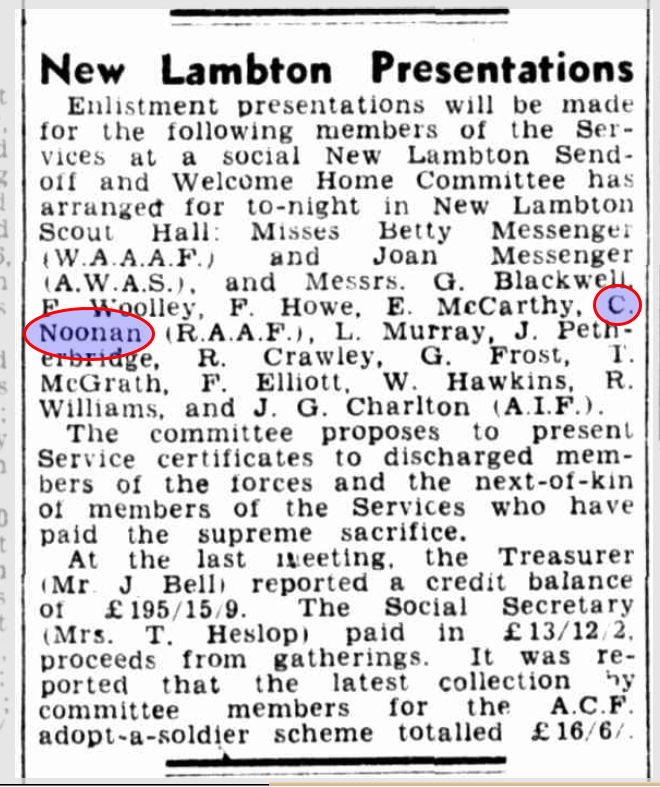
[Early February 1944 brought Clem some very welcome news.]
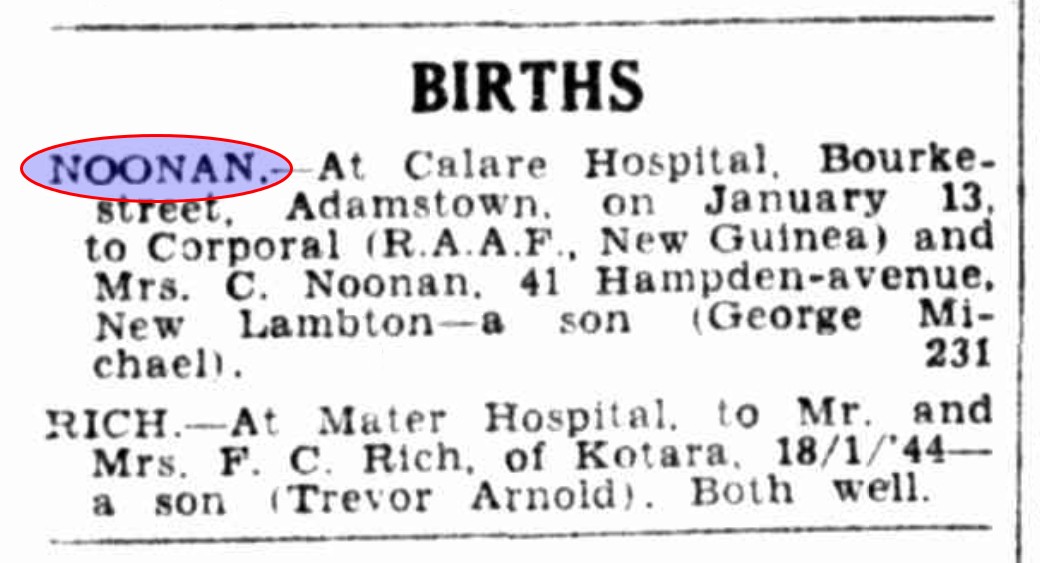
11/2/44 Received grand news of Michael George arrival. It was the best news I’ve had for many a long day. “My son” it sounds and is perfect to me Thank God Shirley is well. I’ve lost 1/2 stone already worrying over her, but her and my two precious babes makes this crazy world worth living in. They’re the only things worthwhile.
 |
16/2/44 My head is showing first signs of getting better after 4 months of treatment – It’s about time as it has nearly driven me mad at times.
 |
(?) 15/2/44 Had the old Malaria back again in the milder form but the headache is still the same. It’s a beaut and no mistake it lasts 7 days.
Colleen’s grass bag shown earlier is accompanied by a small grass skirt that Clem bought for her. It is not known when or where the grass skirt was made but it is very similar to the skirt worn by the native child on the right of the wartime photo below. The strands of grass in this skirt are badly deteriorated and unfortunately it cannot be unrolled without further damage.
Colleen remembers that her mother always forbid here to wear the skirt but it is not known why. As a point of minor interest, Colleen has kept this skirt for many years in a clear plastic bread bag from the Pro-Rol Bakery. For many years Pro-Rol operated across the street from Clem and Shirley Noonan’s home in Belmont South, NSW. As Clem would not have a phone at home, calls for the Noonans would sometimes be placed to the Pro-Rol bakery and an employee would let them know.
Colleen recalls that she originally had a child sized native woven grass bra and shoes to accompany the grass skirt and bag but has no recollection of their fate. Compare the skirt above to that worn by the native child on the right of the photo below.
 |
9/2/43 Had 5 trips down to the bottom of the reef in a diving suit today. It was very interesting. It felt funny being all alone on the bottom of the sea.
 |

16/4/44 The kite I was working on yesterday was struck with lightening. I got quite a kick. Went into hospital today with fever of some sort. Everything a bit hazy.
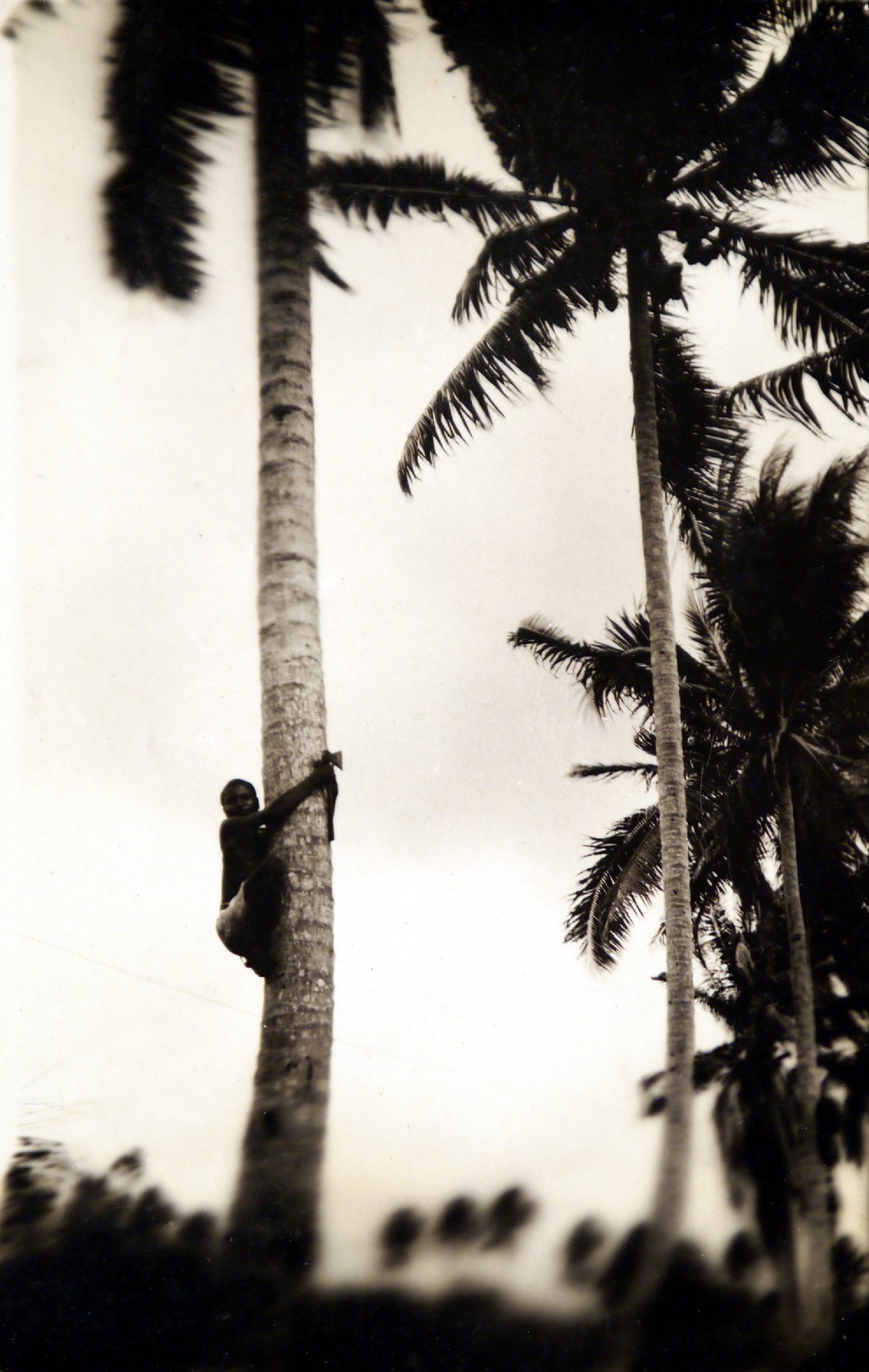 |
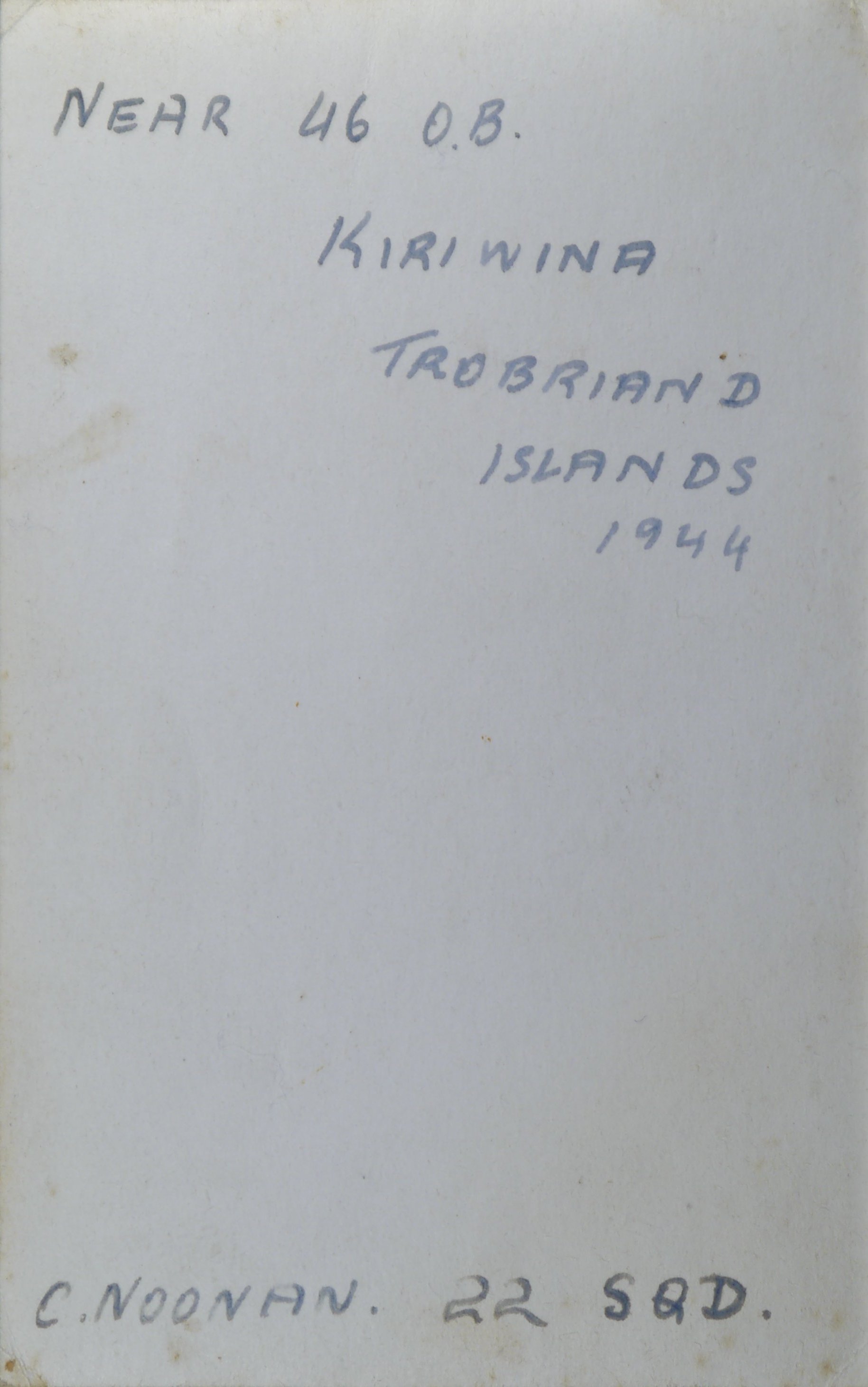
21/4/44 Out again and feeling OK. My head getting much better.
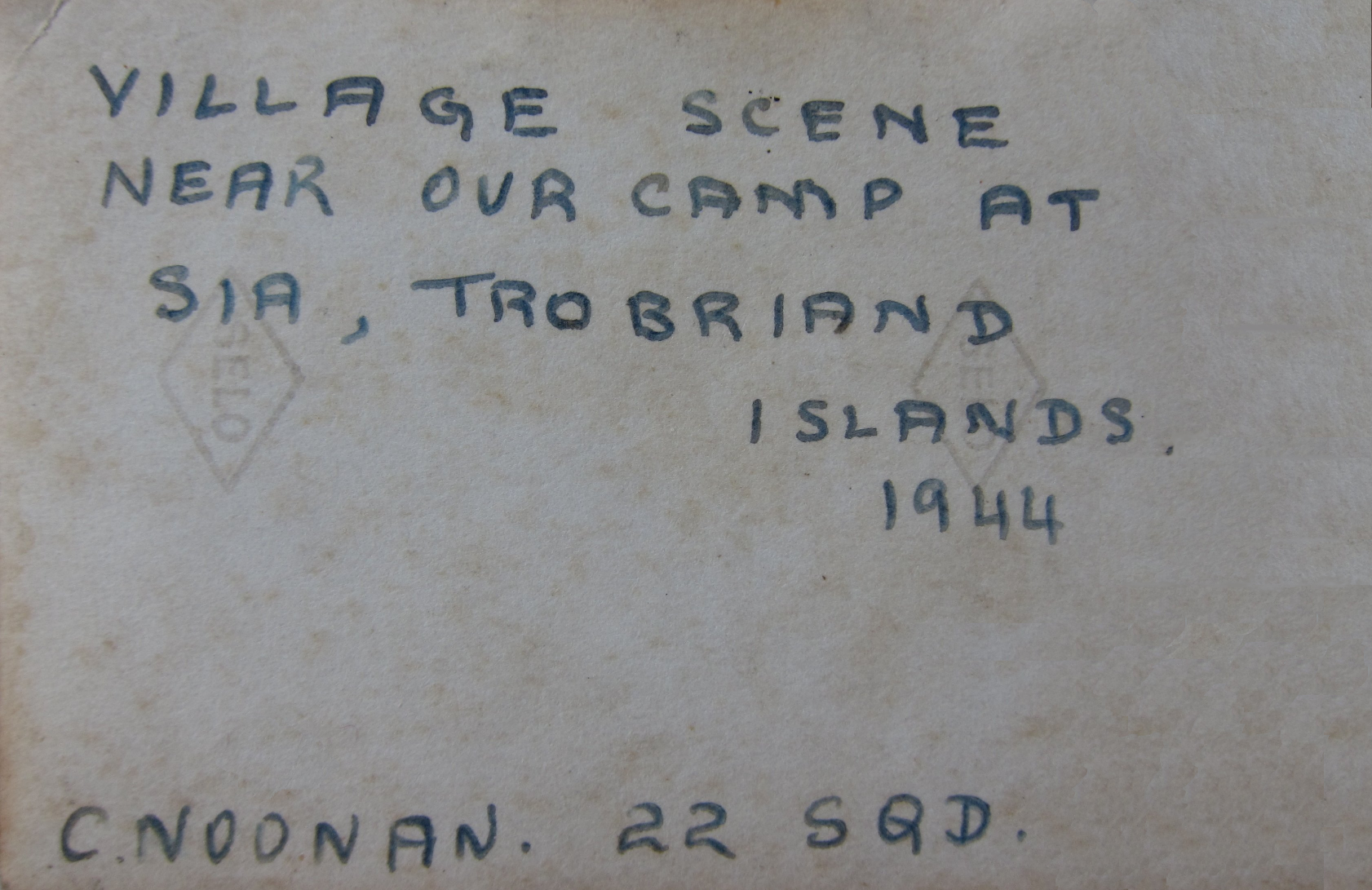
[By May 1944, interest in New Lambton was waning for the enlistment presentations, but the family were given an ‘enlistment gift’ in the form of a wallet for Clem.]
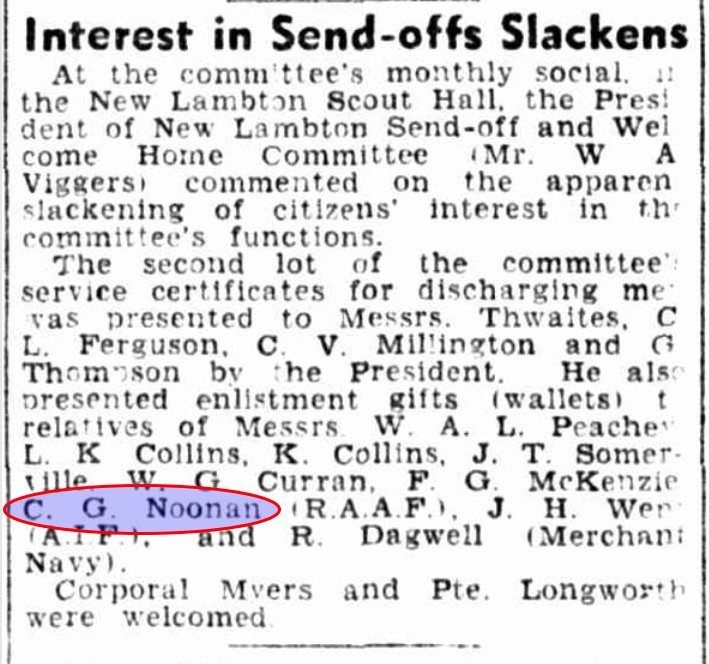
30/5/44 Ian Barknam and I built a boat and we’ve had some good times up to date.
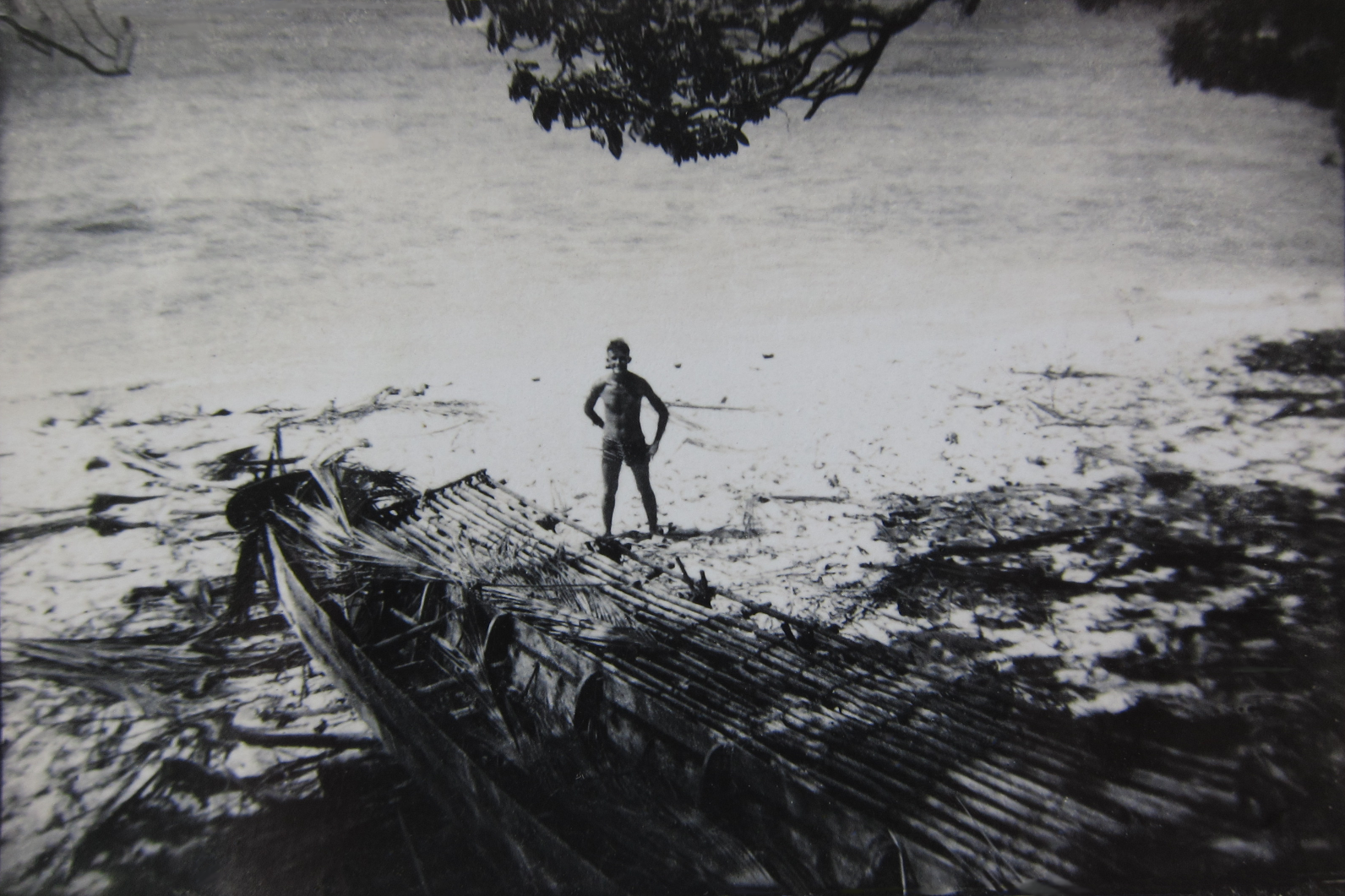 |
| Click on the above image to reveal a colour photo of a similar scene. |
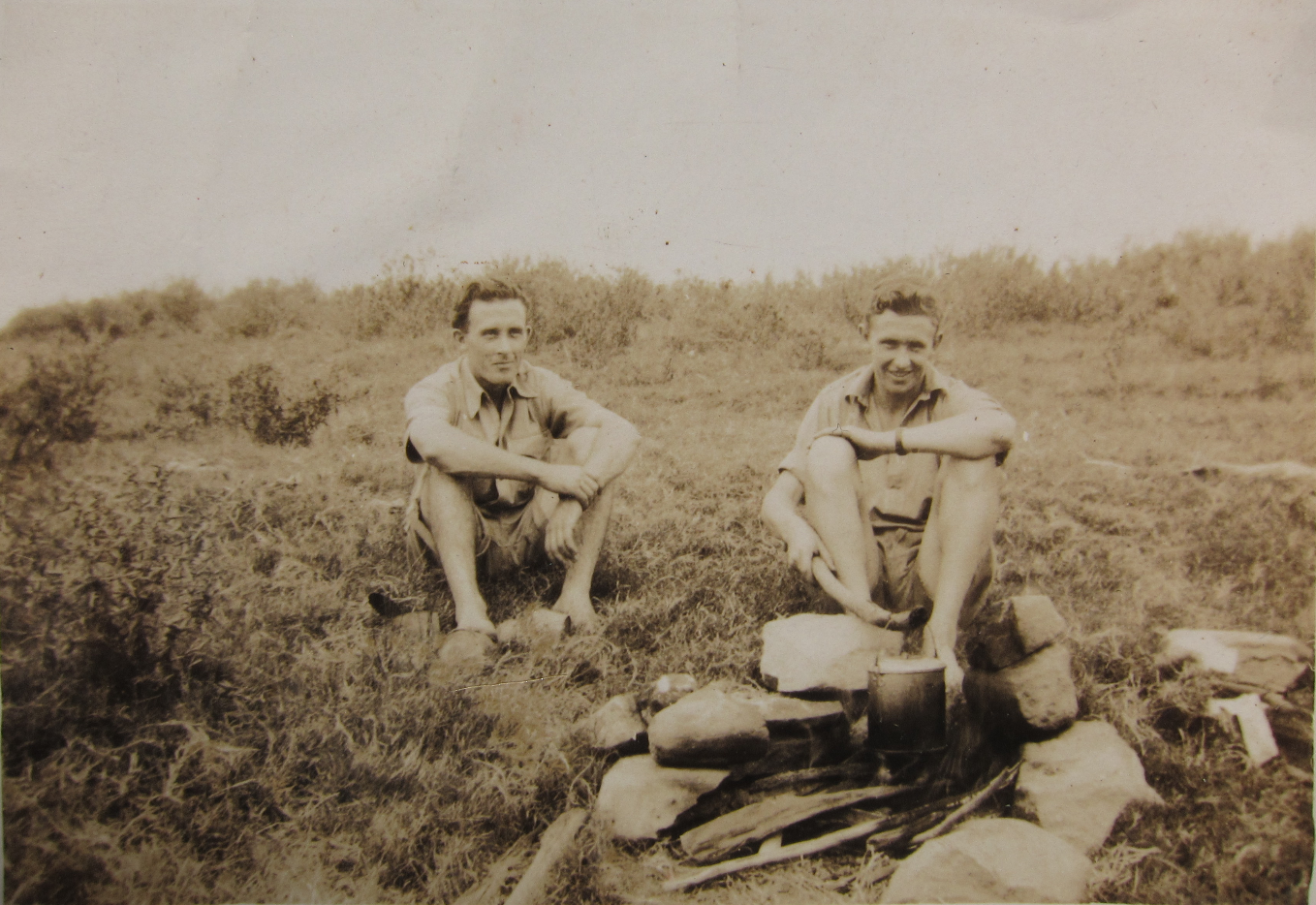 |
| On close inspection Clem’s friend with the billy appears to be the man standing beside the boat in the previous photo. |
30/6/44 Another month over and still the same – plenty of work and not much play. I’m with a very decent gang of boys now and that makes a difference.
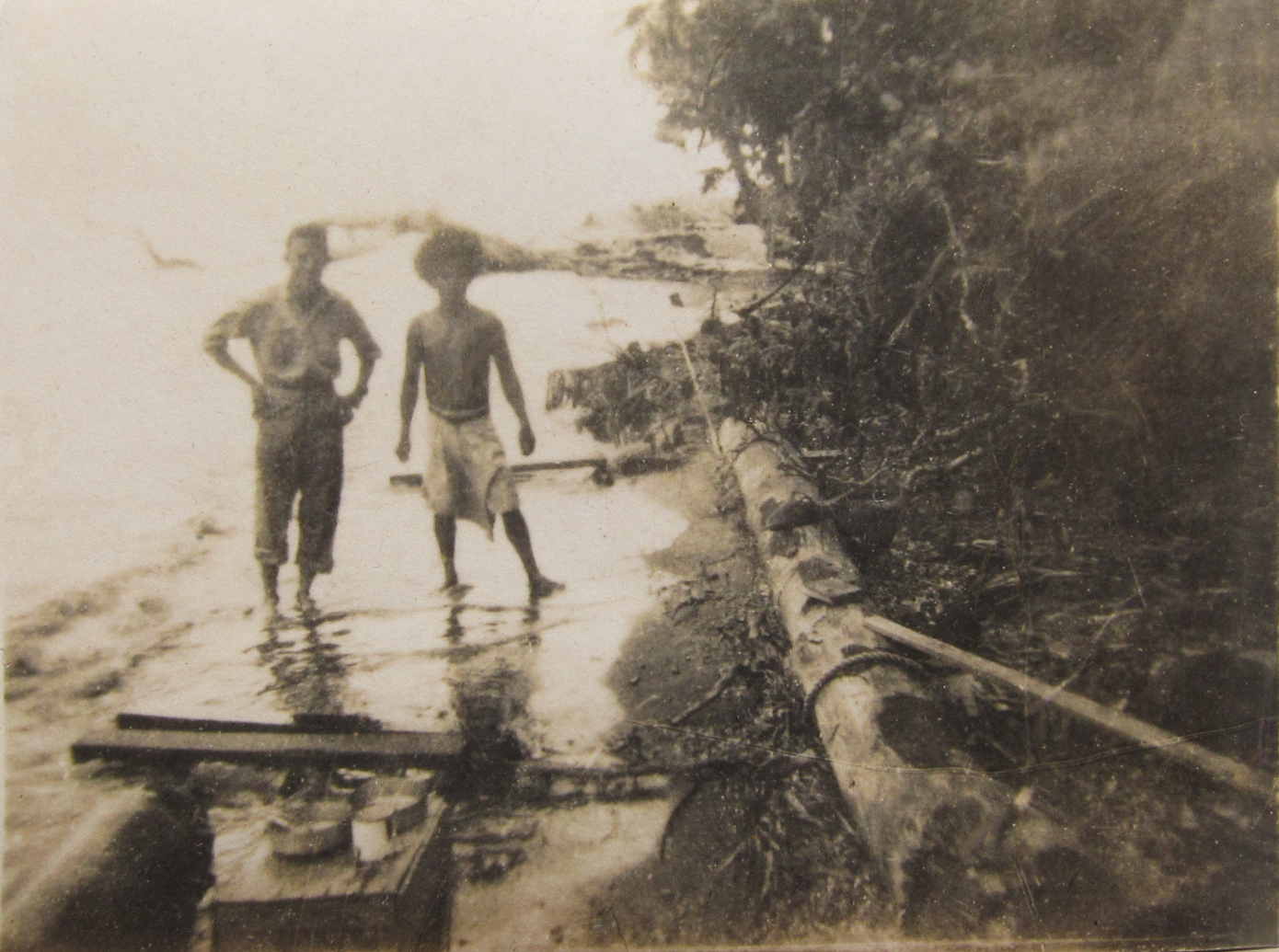 |
| It looks like the boys have just washed the dishes! |
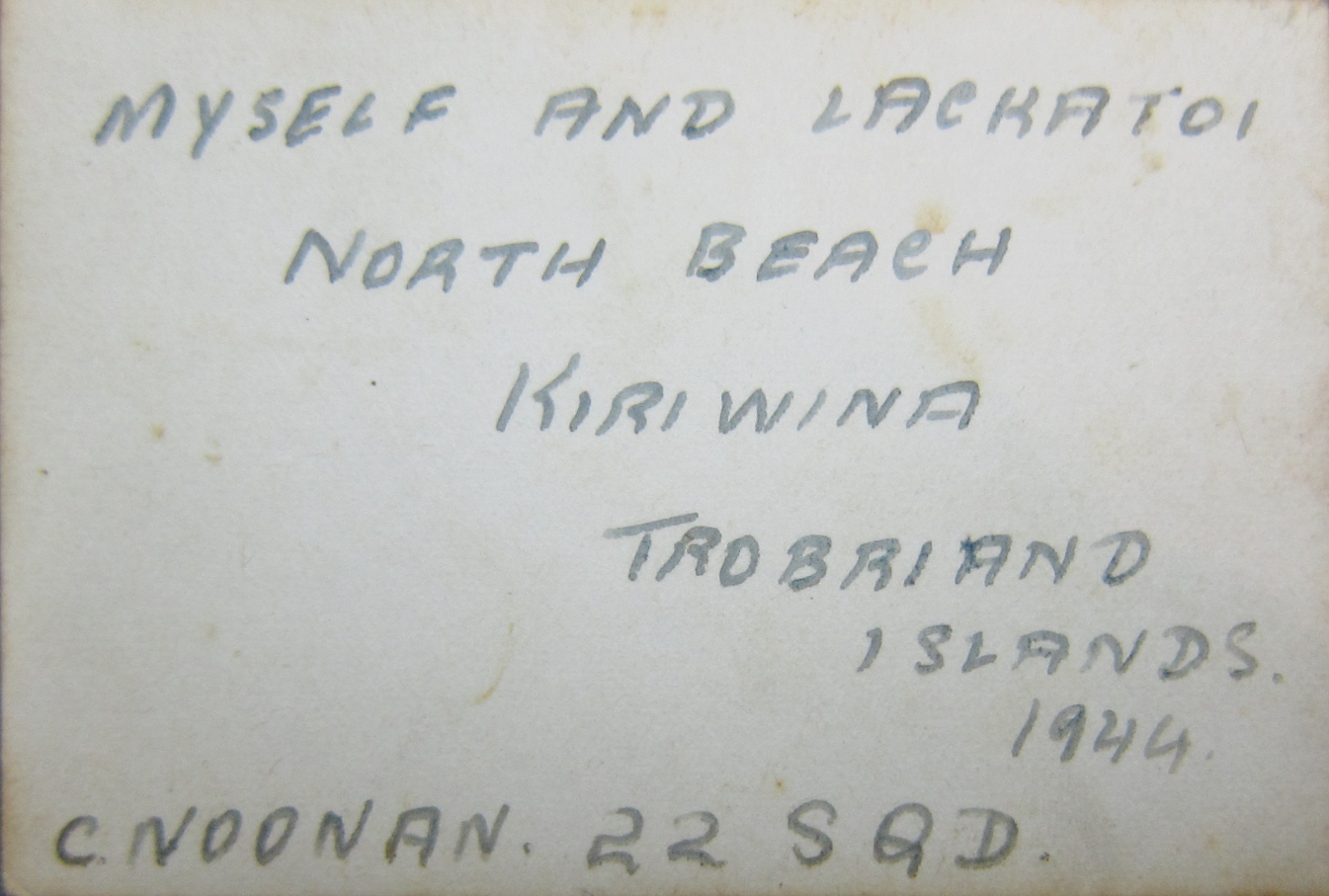
Clem’s last known letter to Colleen was written on Kiriwina (Island) on 14 July 1944. It has survived in very good condition.
4/8/44 Left Kiriwina today end flew to Nadzab by
Douglas C47. Arrived 2pm. Had nice trip although bad weather all the way. Saw Buna, Salamua and Lae.
-4-
5/8/44 Left Nadzab 8.45am and flew right up the Markham rivers (Ramu and Sepik) for their entire length 700 miles, comming out at Hollandia. Looked very nice from 10,000’although very cold and extremely bad weather at times. We continued on over Wadje, Biak islands and landed at Numfoor island, off Dutch New Guinea coast at 2pm. Travelled 1100 miles in 7 hours flying with only one stop. Plenty of Japs still on the island, about 500 of them. We can hear them come down to their gardens at night with the dogs. The yanks are out after them all the time, getting a few each day. The Japs had their geisha girls with them also Kurilian and Korean slaves. There is plenty of Jap equipment about, wrecked planes and infantry equipment. We have had 2 raids and at least 1 alert every night so far. Madame Togo told us they were going to wipe us off the island last night. The island is 12 by 15 miles in size,the most advanced allied base in this area and we are part of A/C Sherger’s task force. He is a good chap as regards us in particular, but now he has been returned to the main land after being badly injured in an accident
 |
13/8/44 Three raids last night. Tomorrow makes 12 months completed in the tropics by date. The guards woke us up the other night, there was a Jap loose in our camp. He somehow got through the perimeter and was after food I think. We each got a welcome ready for him, machine gun type, but he slipped through to the jungle and got away. The main Jap force is only a few miles away from here but up to date they have made no attempt to break through. I have my own machine gun beside my bed and I feel quite confident of taking care of myself. Ted Harpley, Denny Nilligan, Bob Boston and myself have the last tent on the perimeter and we have been keeping, a close watch. I have a machine gun and the others have rifles. I’ve had a lot of practice with my MG and I have it down to a fine art, no kidding, I can put those .45 just where I want them. It gives you confidence and a feeling of security.
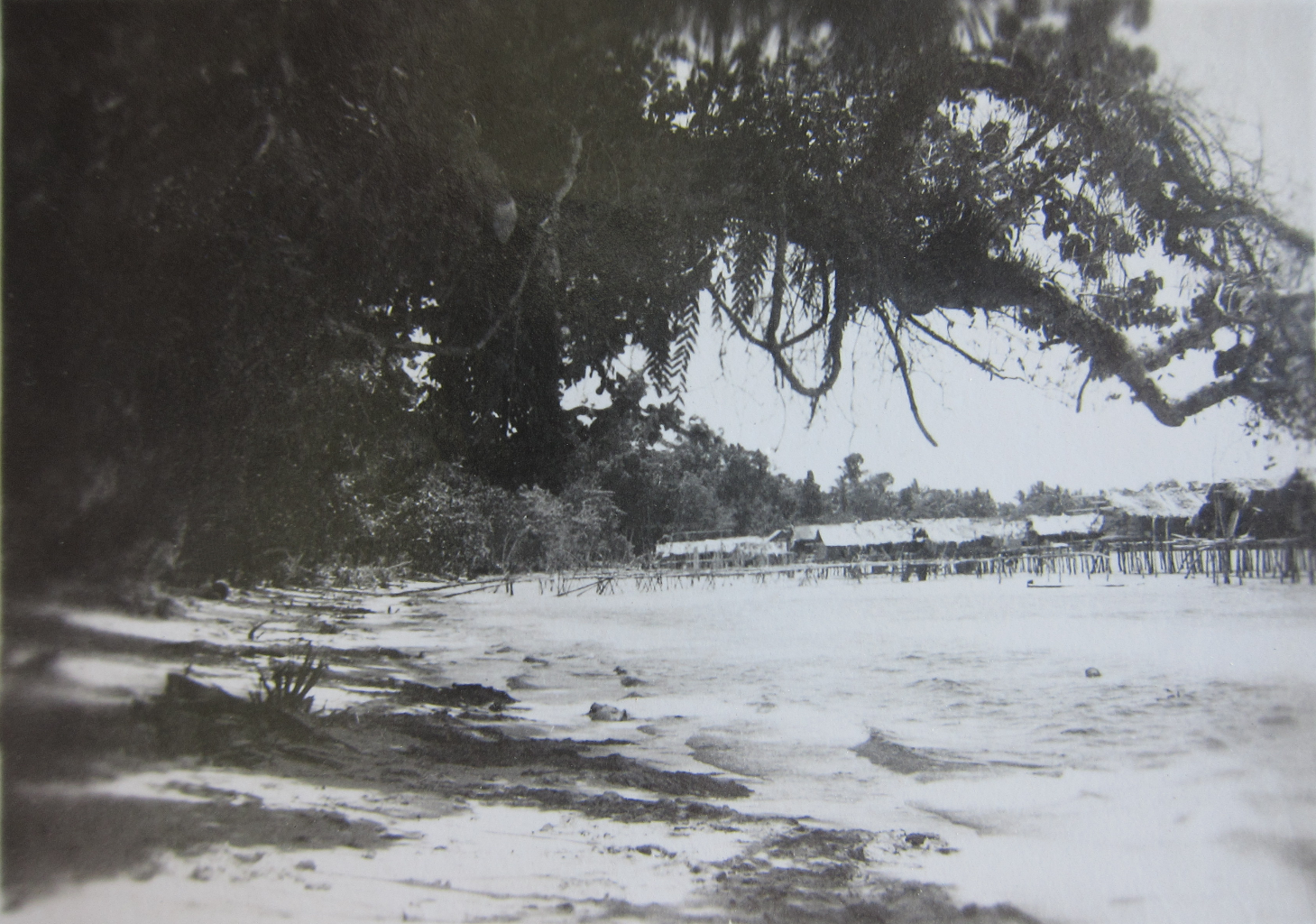 |
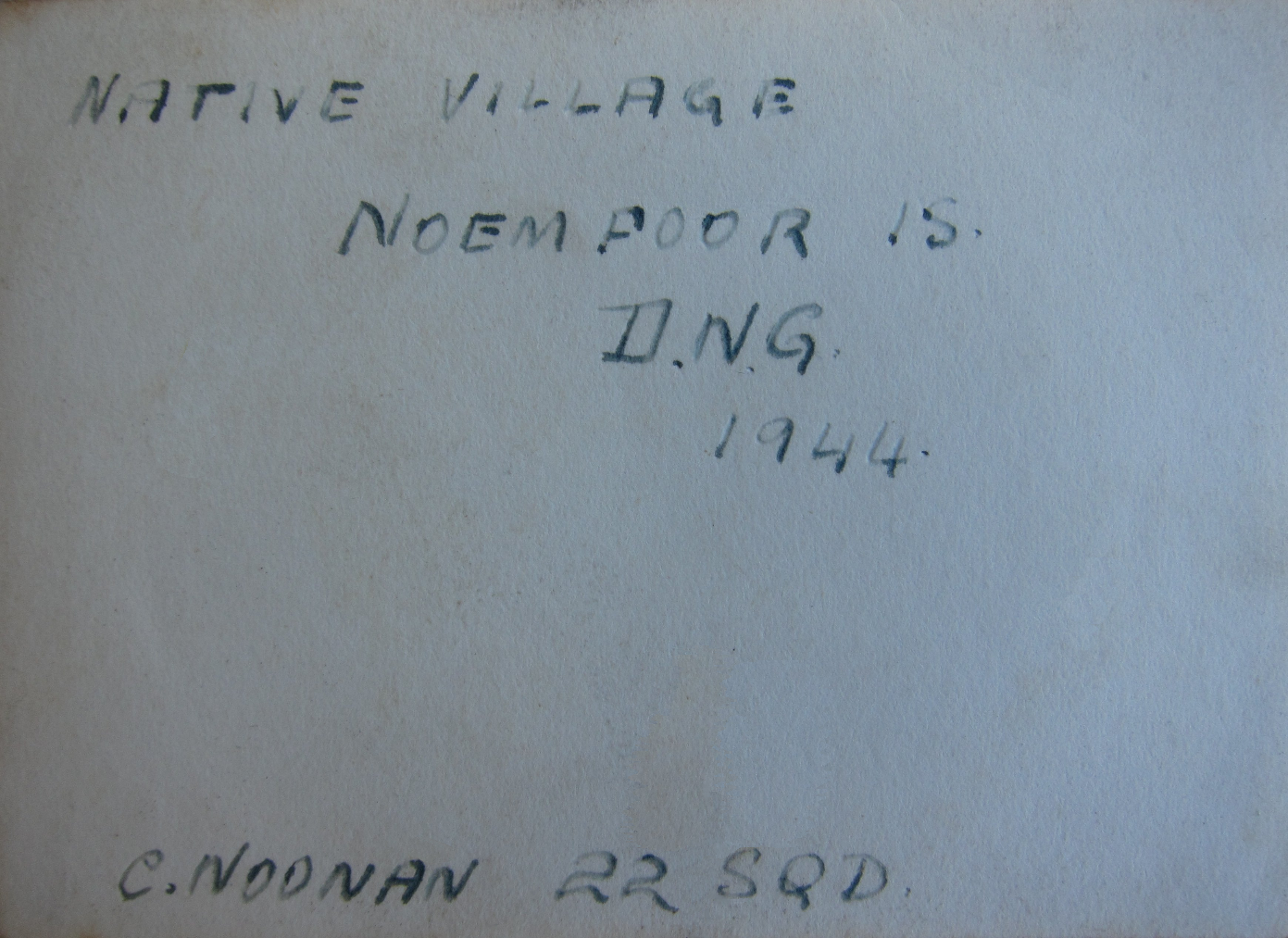
15/9/44 Numerous raids lately and Jap Reccos over too during the day, we,ve had several bad smashes lately and yesterday five of our fellas were killed. It makes you wonder at times, it all seems crazy to me; all this death; destruction. I shouldn’t say this I suppose but I hope these yellow skunks get it in the necks. They will I feel sure, sometimes I think they are not all human. When decent chaps have to die to make it safe for us at home. I often wonder what kind of a world is it. I’ve seen all I want to see of war and its rotten business.
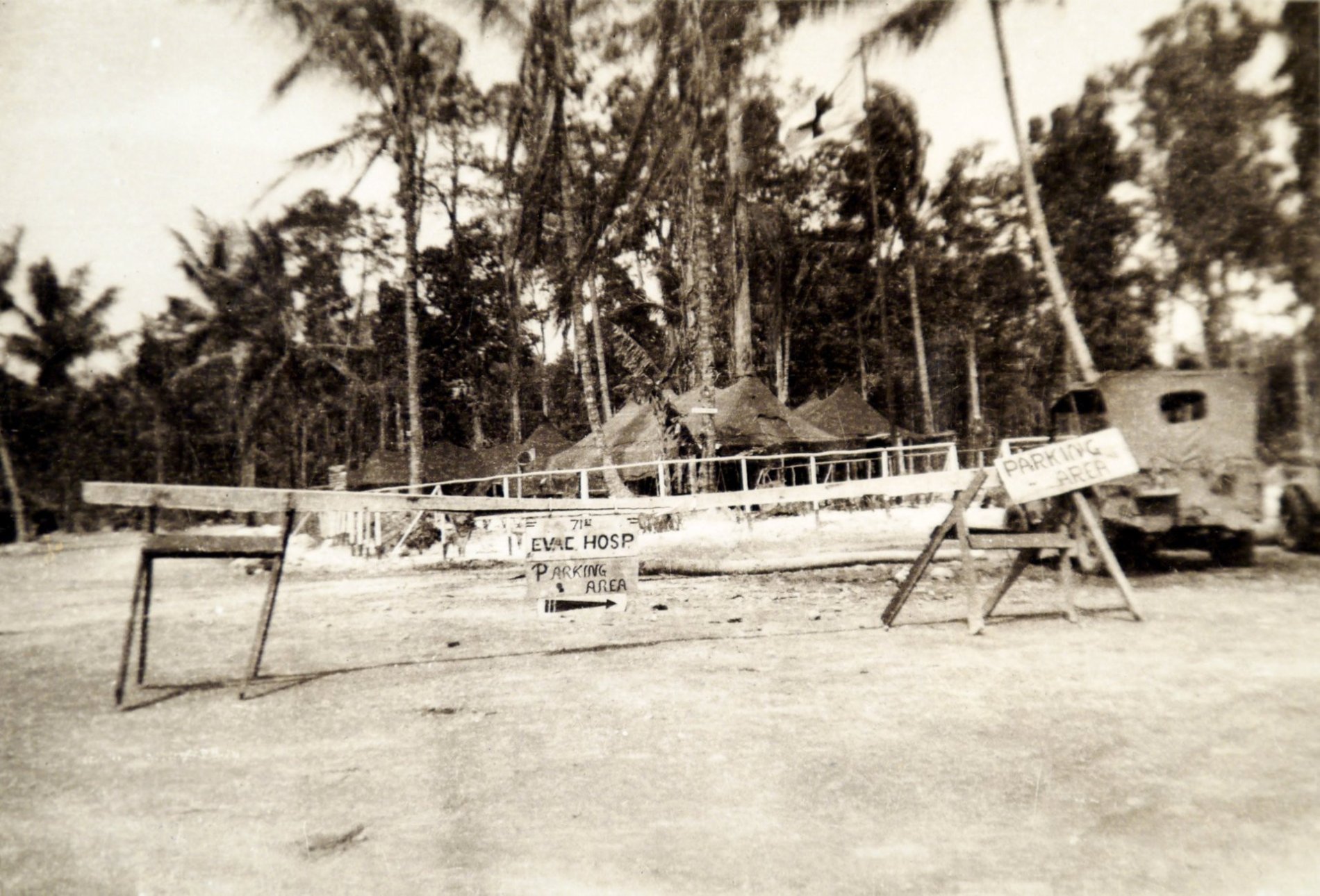 |
17/9/44 Just as I sat down to write tonight the A.A. fired 3 shots. It was an air raid. This is nothing unusual but just as we get to our trenches some wag started playing “Praise the Lord and pass the amunition” on a trumpet. It helped break the tension anyway.
-5-
26/9/44 Things are pretty grim we’ve had 11 chaps killed in 10 days. I knew them all bar 2 and it doesn’t seem right to me some people call this modern civilization, I wonder.
 |
8/10/44 Another raid this morning. Jap kites over but bombs fell away from our camp. Got the warning at ten to three this morning and got to trench about 5 minutes before we heard bombers overhead.
10/10/44 Another raid tonight but nothing to worry about.
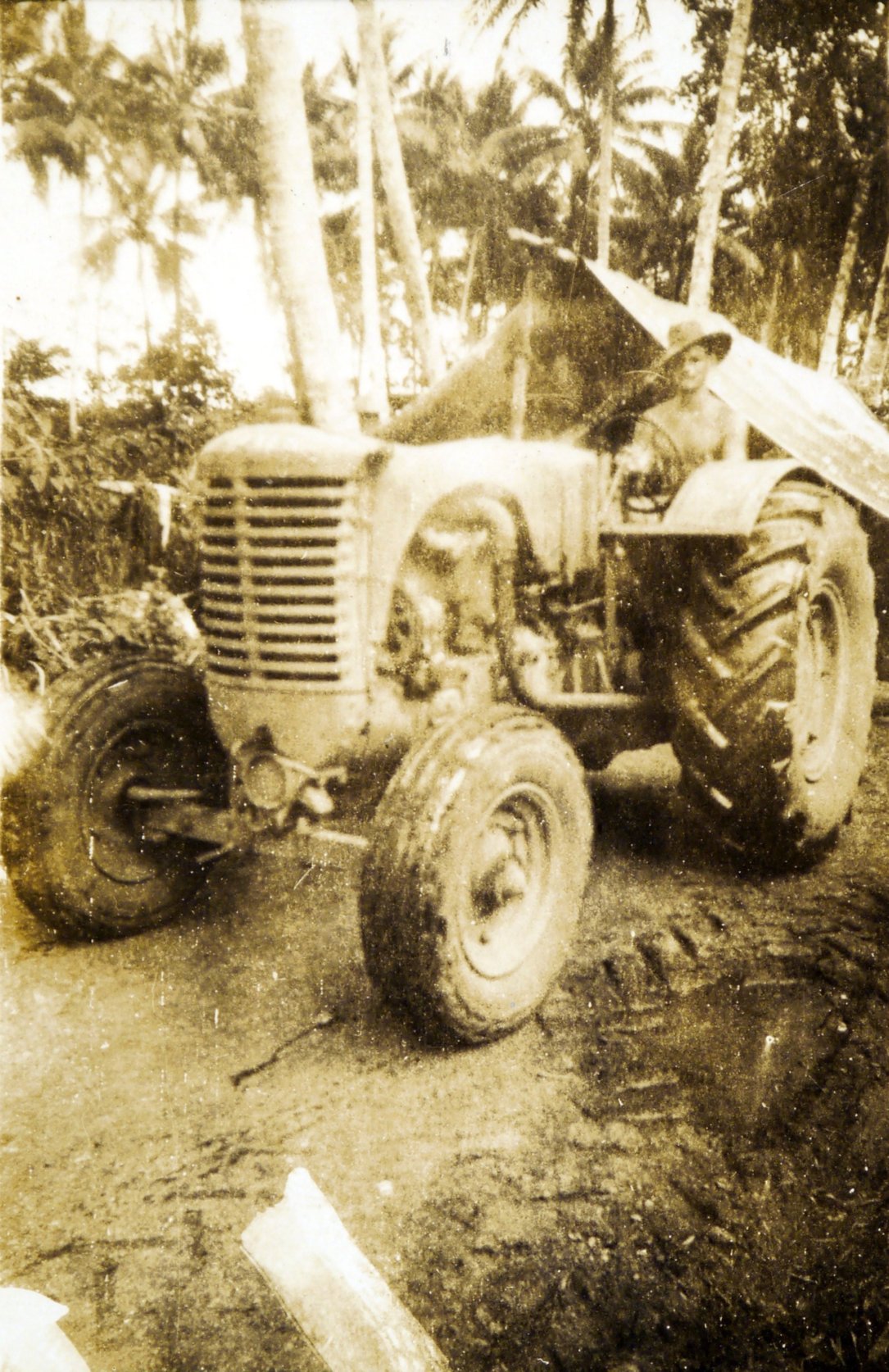 |
27/10/44 Got my sarge today. It’s back dated 3 months. Another raid tonight but nothing came of it.
30/10/44 Still no sign of my posting yet, I’m getting desperate.
Clem’s diary ends somewhat abruptly on 30 October 1944. He arrived at No.2 Personnel Depot (2 PD) in Australia two months later, on 2 January 1945, one month before his eldest son Michael’s first birthday. While Clem had been able to visit Shirley and his eldest daughter Colleen before he went overseas, this would be the first time he had ever met his son.
A review of his actual diary confirms it was not a lack of paper that prevented further journalling, nor have pages been lost from the diary.
Circumstantial evidence suggests that in mid November Clem moved to Morotai with 22 Squadron for a three week stay. Clem’s RAAF service record contains no record of him serving at Morotai, but then it also doesn’t mention his one month stay at Milne Bay. We know he was at Milne Bay from his diary entries and the captions on his souvenir photos.
I have pieced together a chronology of Clem’s probable movements in November and December 1944 using the Australian War Memorial’s official history of the Second World War, the 22 Squadron Operations Record Book, and Clem’s RAAF service record. The chronology can be found here.
ANECDOTES
Dianne Baxter (nee Noonan), Clem’s second oldest daughter and third child, recalls (over?)hearing a story about a horrendous scene Clem witnessed in which one of his good friends was a victim. Based on the anecdotal facts, it seems probable that the incident occurred on Noemfoor Island, and consequently between 5 August and early September 1944. By early September all Japanese on Noemfoor Island had been killed. If you wish to know more about the Japanese war crime, click here.
Another anecdote probably also relates to Noemfoor Island. In one version of the story, the Australians used to make trouble for the Japanese by discovering their food stores and puncturing tins of canned food with tiny holes. The tropical conditions would promote botulism contamination of the food causing food poisoning or death. In a second version of the story, the Australians would leave punctured tinned food for the Japanese.
Every one in the family knew just how little Clem thought of the Japanese.
Michael Noonan tells a story about Clem being very very sorry about an aircraft he knew to have an (hydraulic??) oil leak being cleared for take off (with several people on board, possibly some being repatriated home) against Clem’s best efforts to stop it, then going missing without trace? Michael says his father was very affected by this incident in which his father’s protests were seemingly overruled to the peril of those on board. Barry adds “I can’t confirm Michael’s story about the hydraulic leaking aircraft but such incidents are commonplace during war. I can confirm from personal experience that the routines of the RAAF in peacetime are a far cry from what happens under wartime rates of effort. Risks have to be taken and are (in wartime)“.
Although only a small boy at that time Barry Noonan still has flashes of memory from the period and distinctly recalls Clem coming home to New Lambton on home leave (staying over on two occasions). On one such occasion Barry recalls Clem’s blue kit bag with A21202 stencilled on it, and Clem being in uniform when all (at the family home in Kings Road new Lambton, NSW) rushed to the door when he arrived, and that he brought souvenirs and gifts for them. Barry recalls having seen the grass skirt and the woven bag, possibly during Clem’s home leave during January 1945.
References for this Section
Ref [1]: Australia in the War of 1939–1945. Series 3 – Air, Volume II – Air War Against Japan, 1943–1945 (1968 reprint)
http://www.awm.gov.au/histories/second_world_war/AWMOHWW2/Air/Vol2/
Chapter 15 – To Noemfoor and Morotai
Chapter 17 – Redeployment
Chapter 18 – First Tactical Air Force and the Philippines
Ref [2]: RAAF Unit History sheets (Form A50) [Operations Record Book – Forms A50 and A51] Number 22 City of Sydney Squadron http://recordsearch.naa.gov.au/scripts/Imagine.asp?B=1158581
(fortunately one of the few available online from the National Australian Archives)
Ref [3]: Service Record for Service Number 21202, Clement George Noonan. http://recordsearch.naa.gov.au/scripts/Imagine.asp?B=4583685
Ref [4]: Conversation with Chris Noonan, 30 August 2016 “He and I used to spend a lot of time together, because we had similar interests, like building boats. When he was working, like on the boats, he’d tell me things, and one of them was about times when they were short of aircrew. You know in those times it was “all hands on deck”. He had to go along on those missions as a gunner, like a tail gunner, in those smallish bombers they had. It was more than once and ‘at least’ on two occasions.”

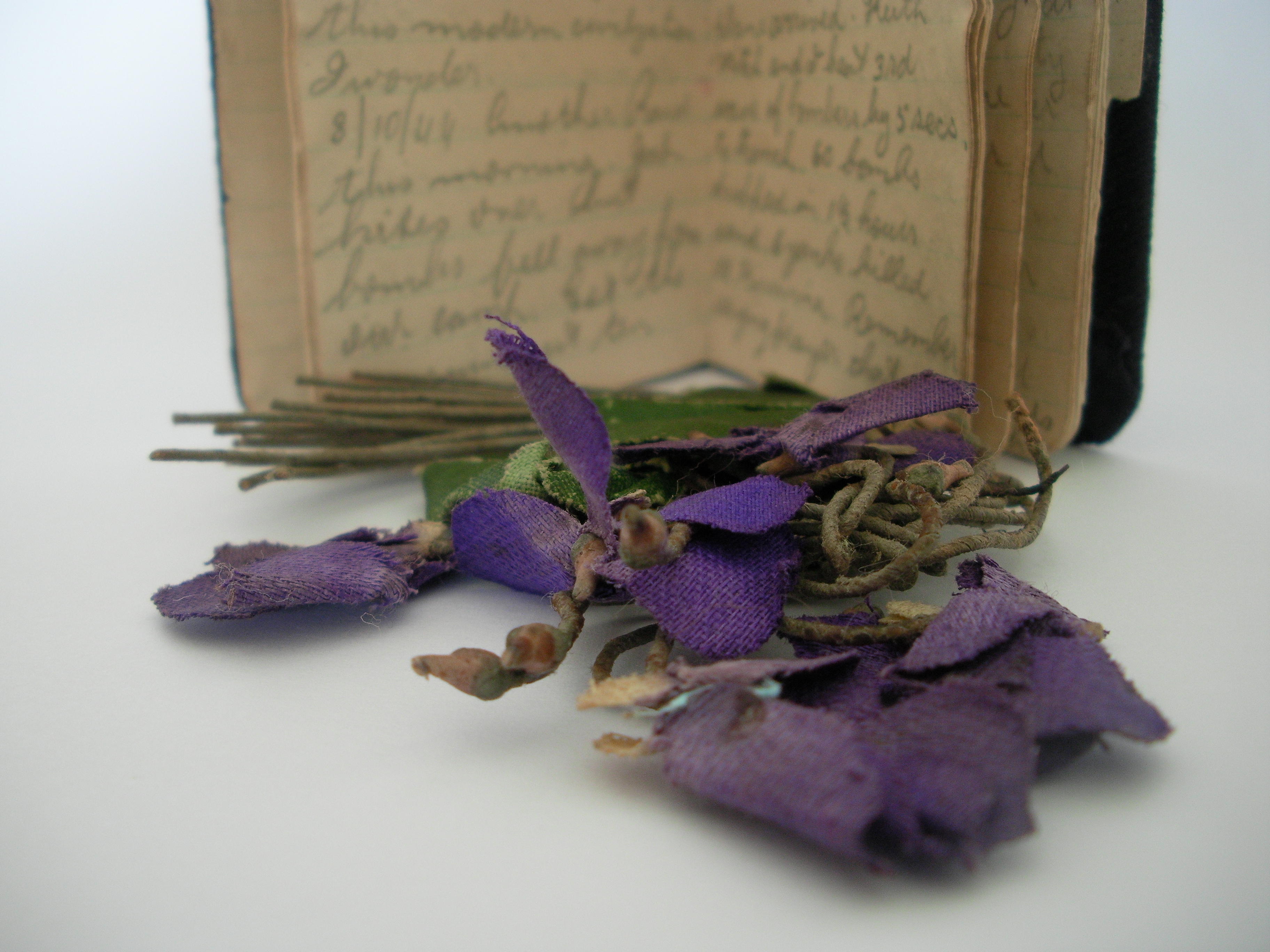


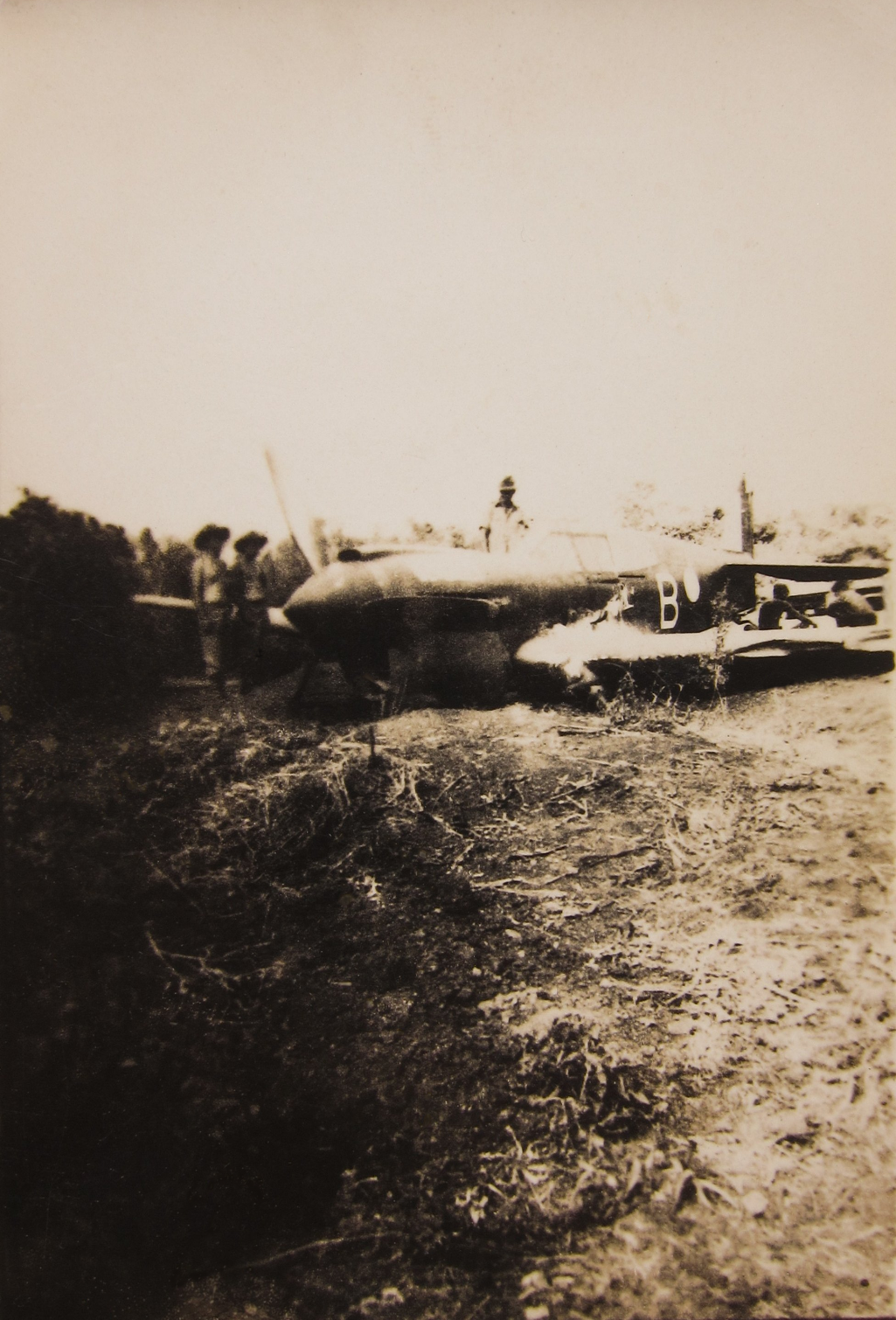


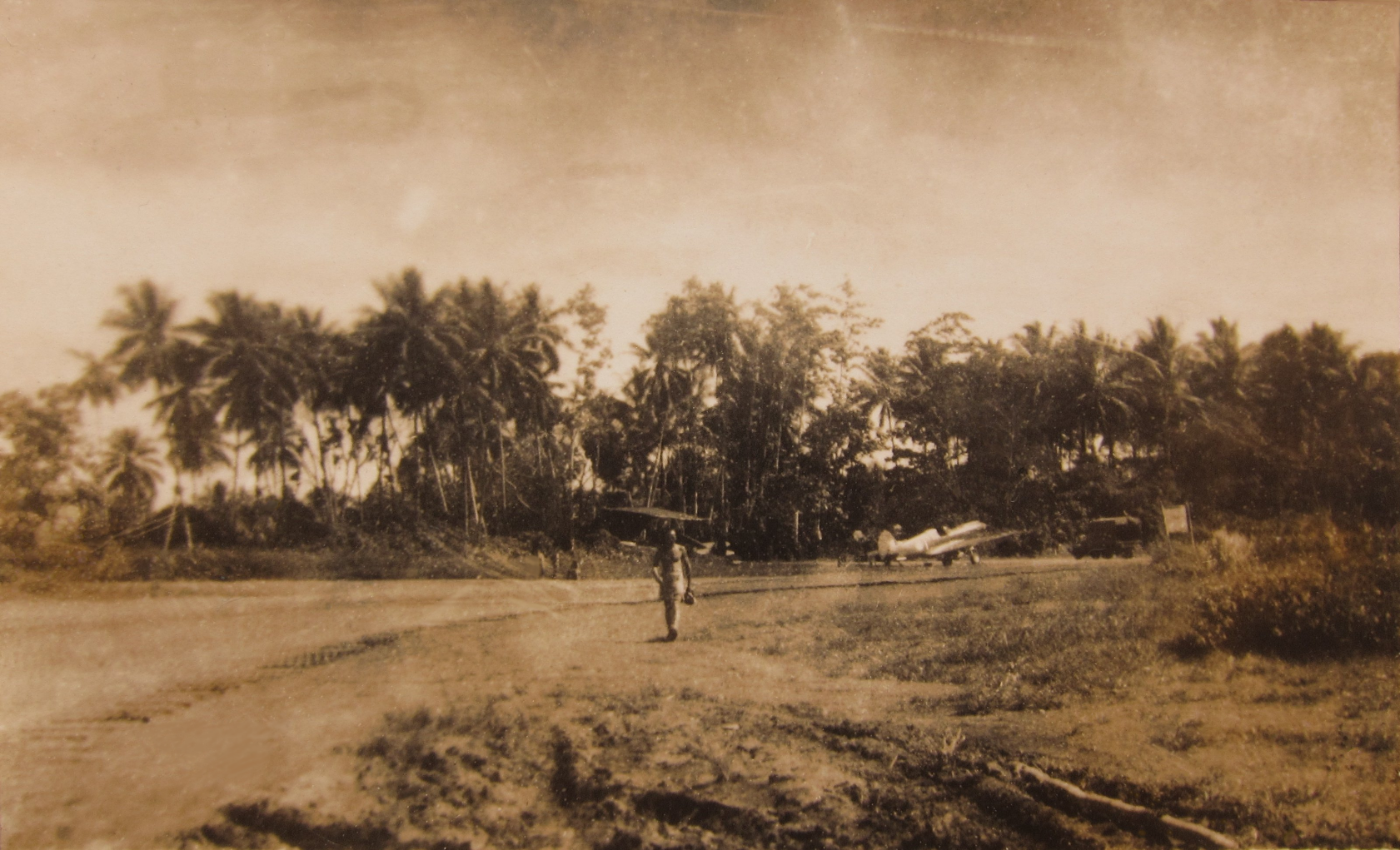
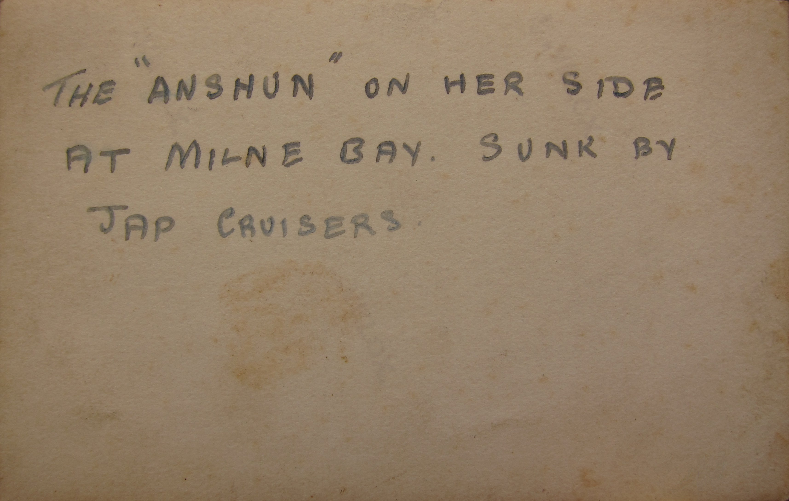



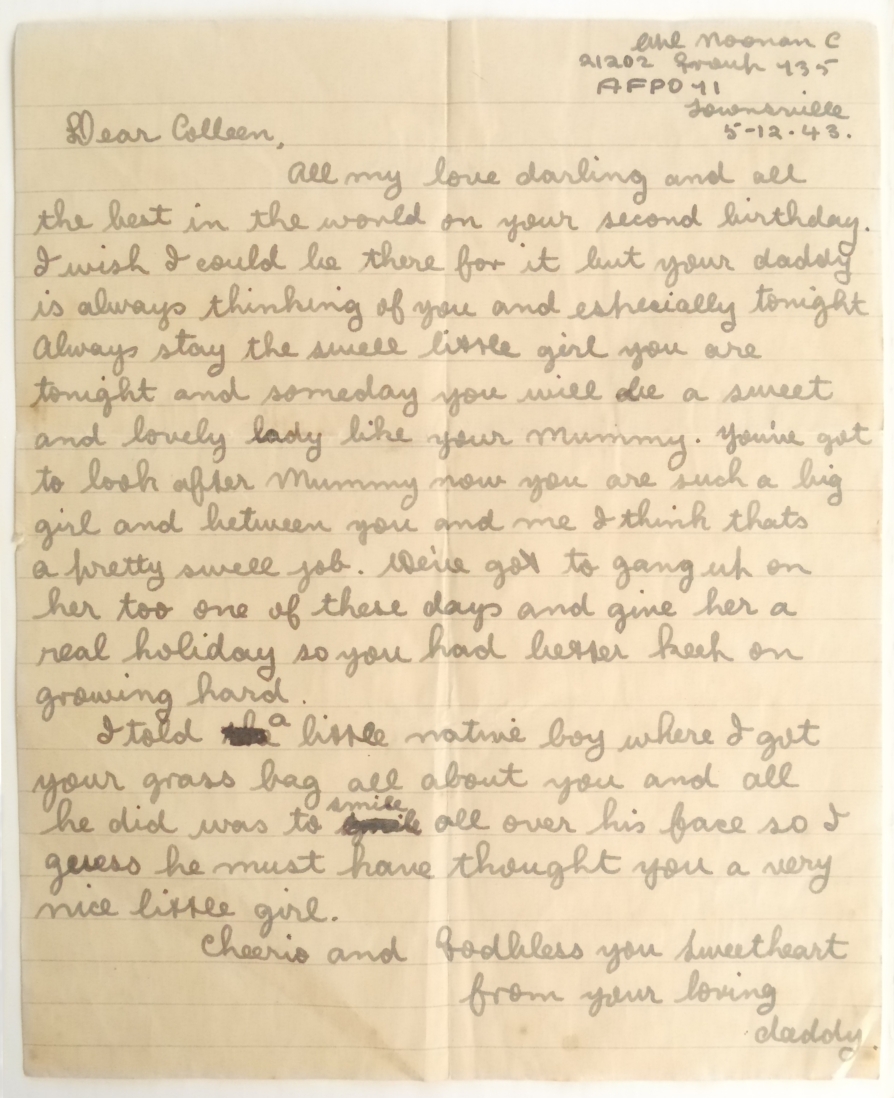
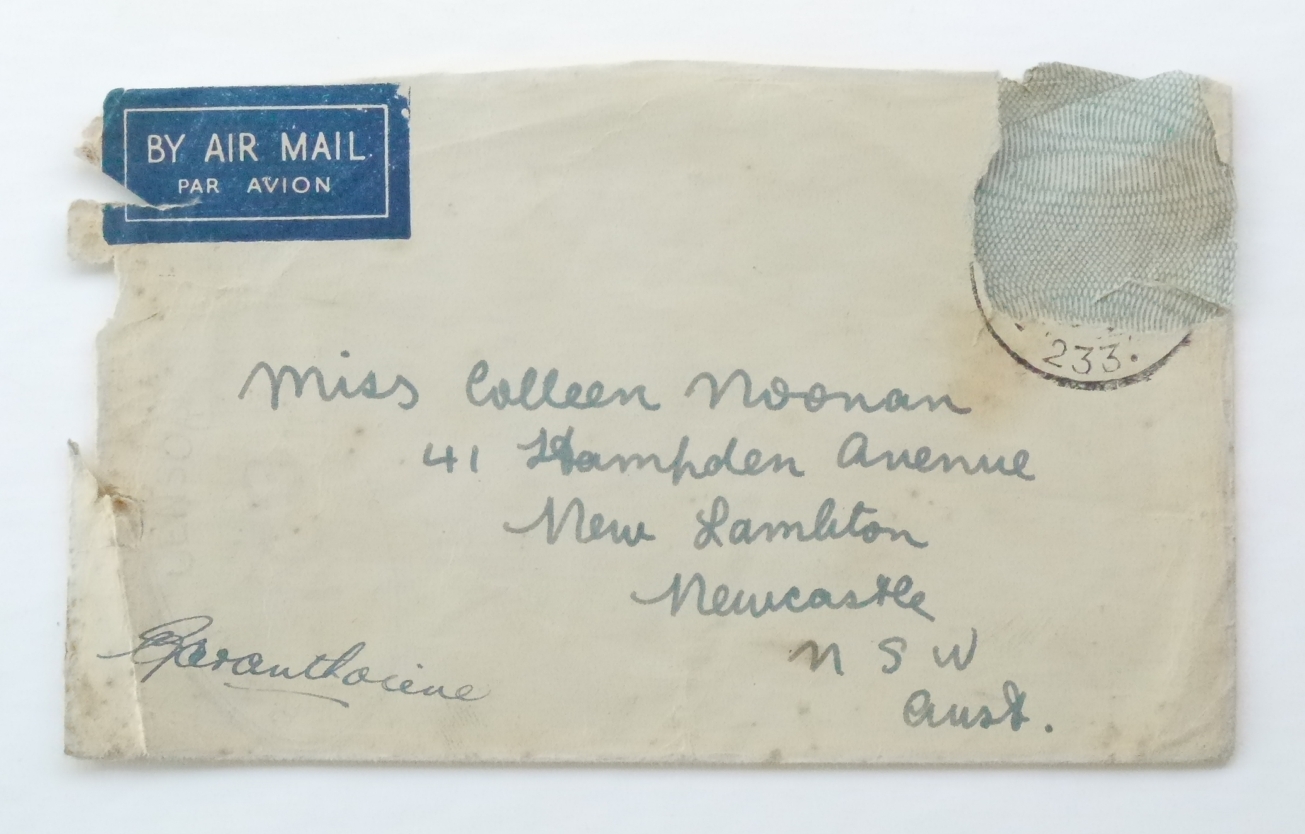
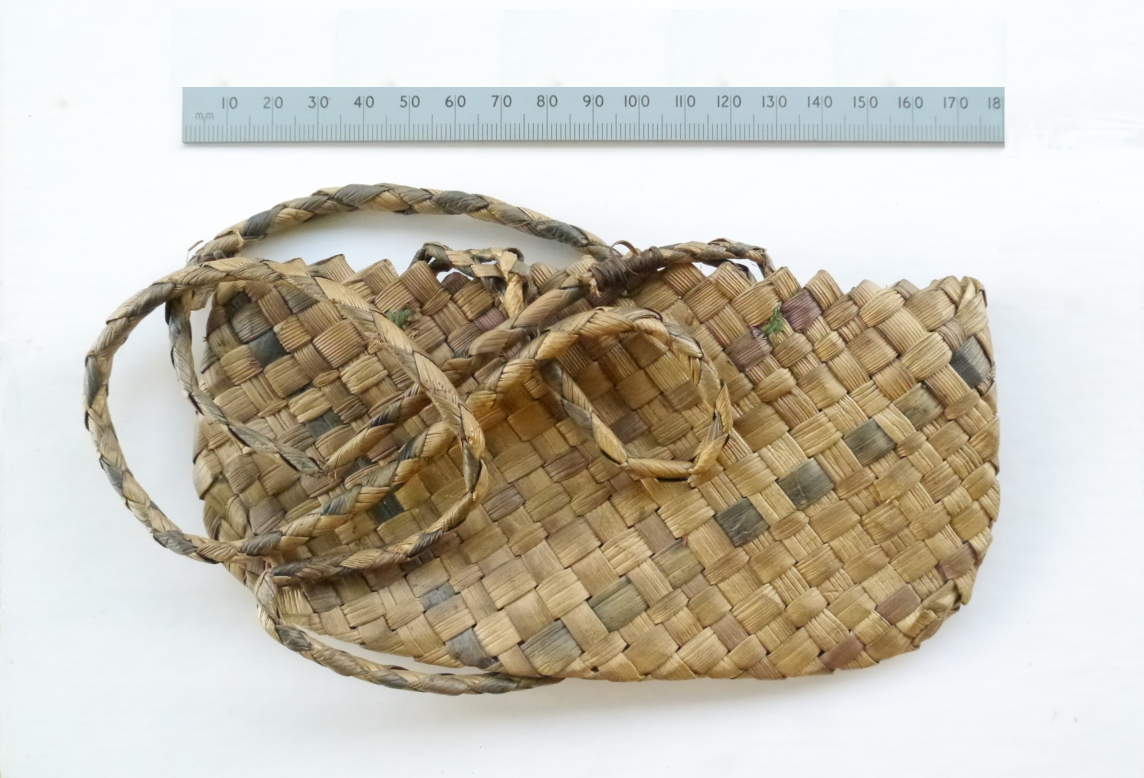
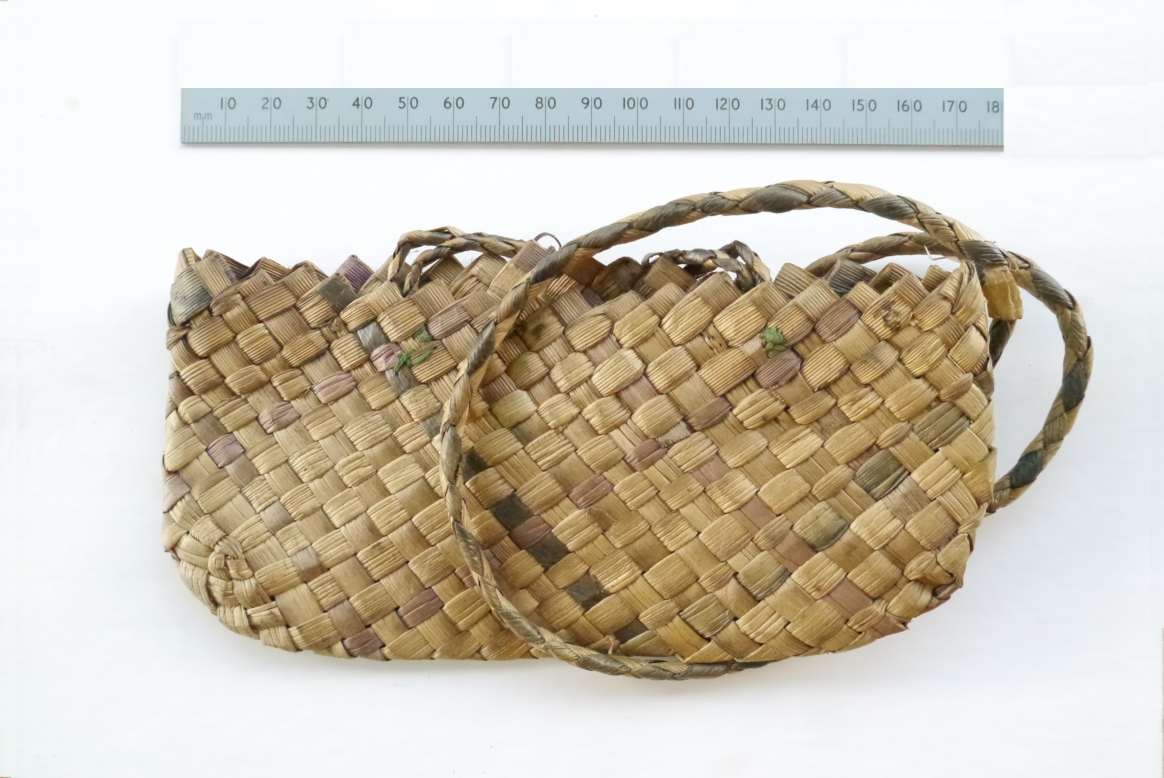

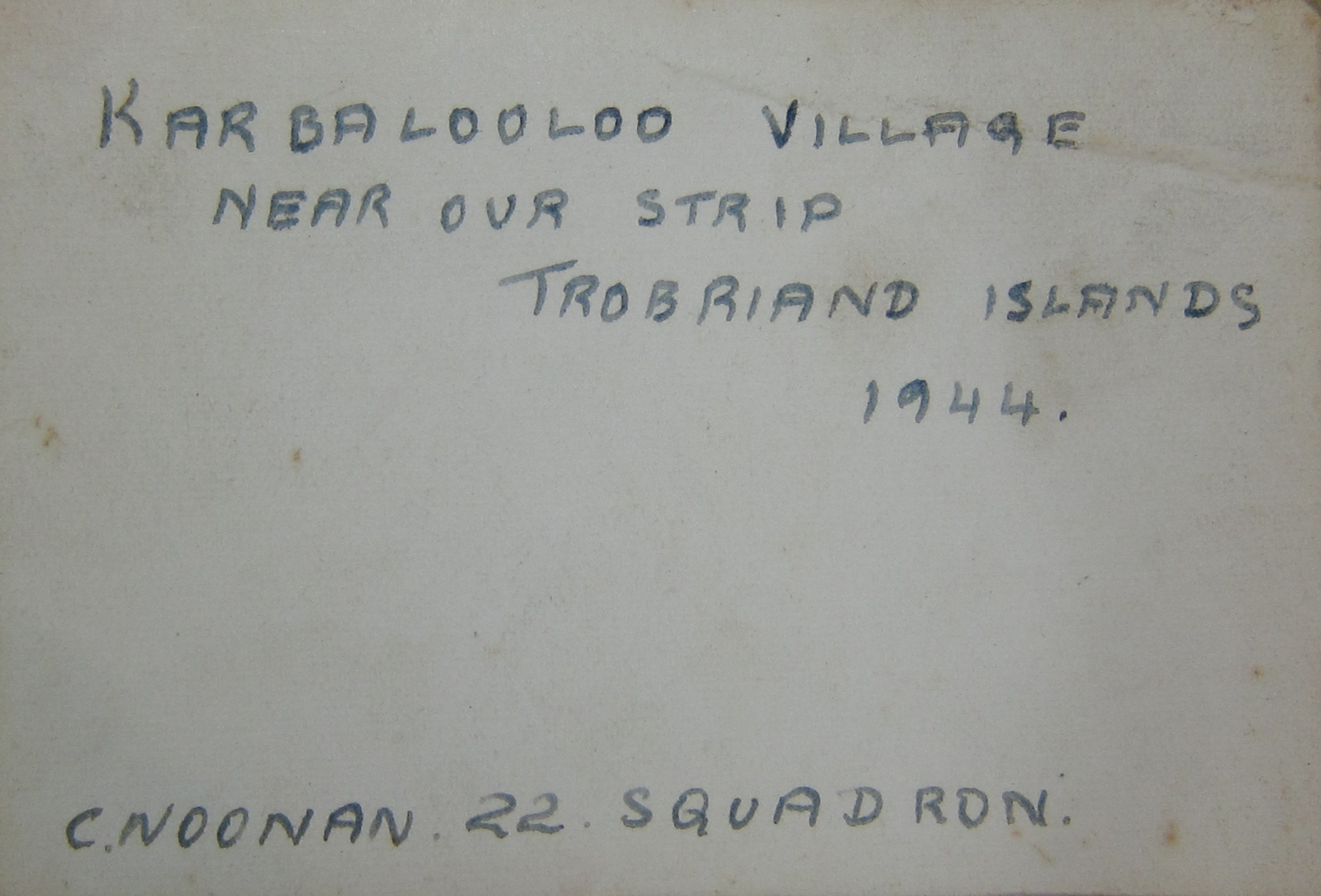


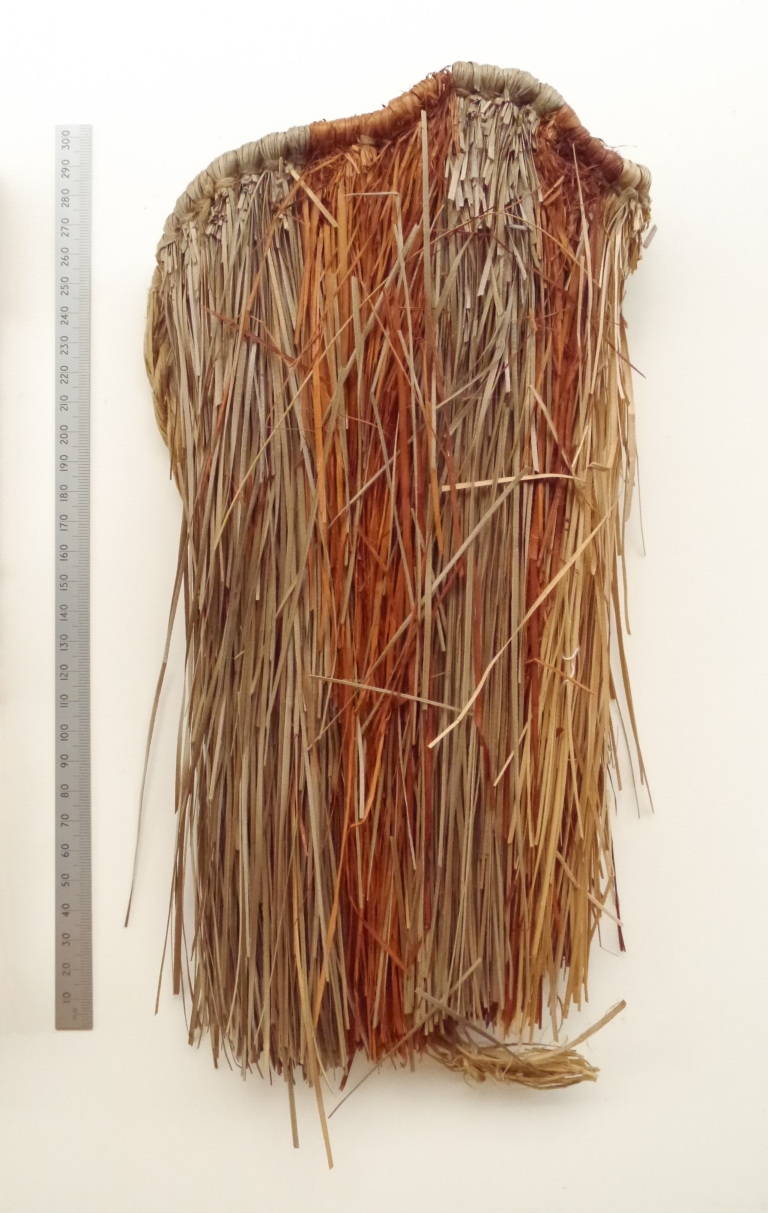

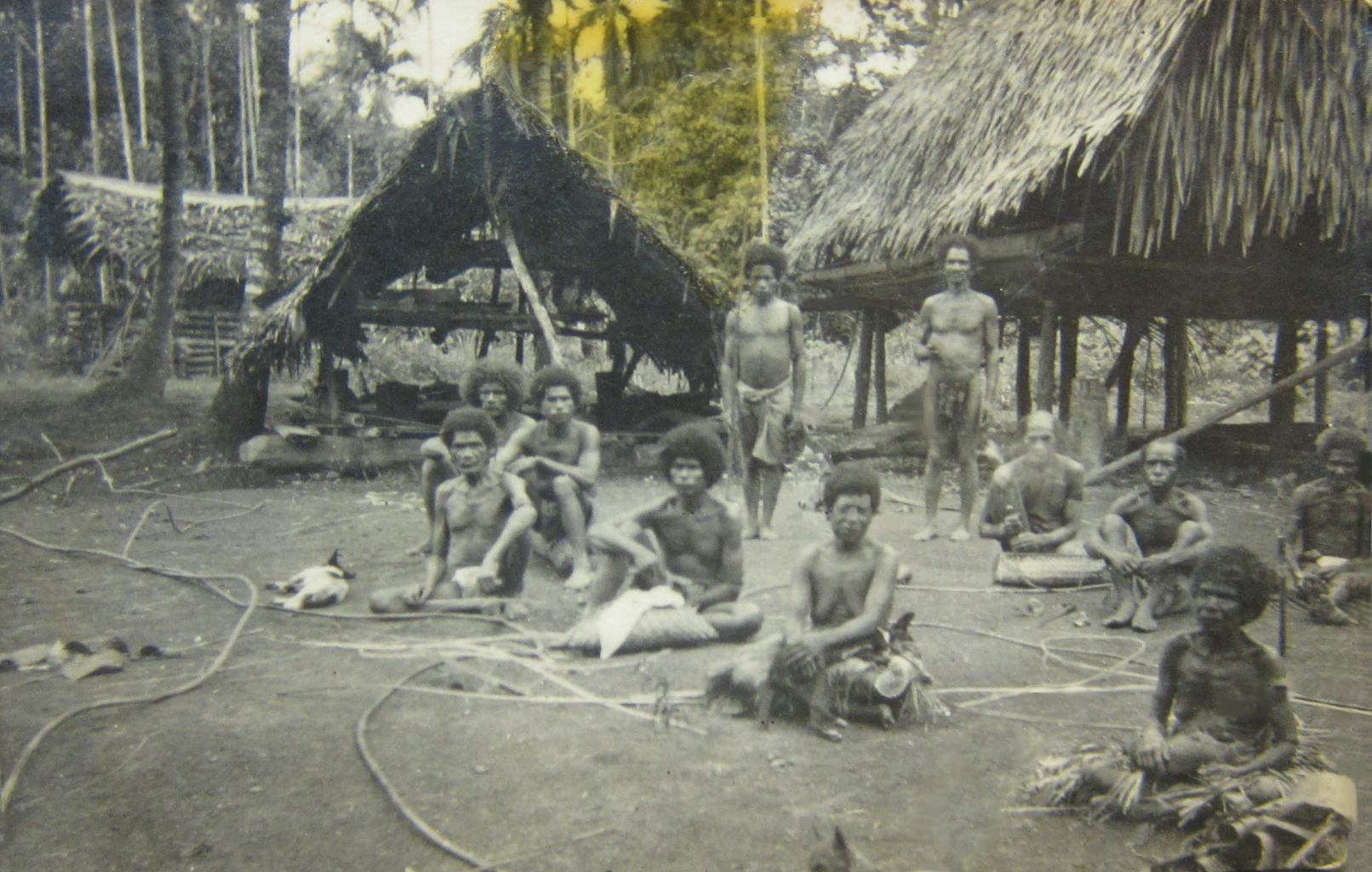
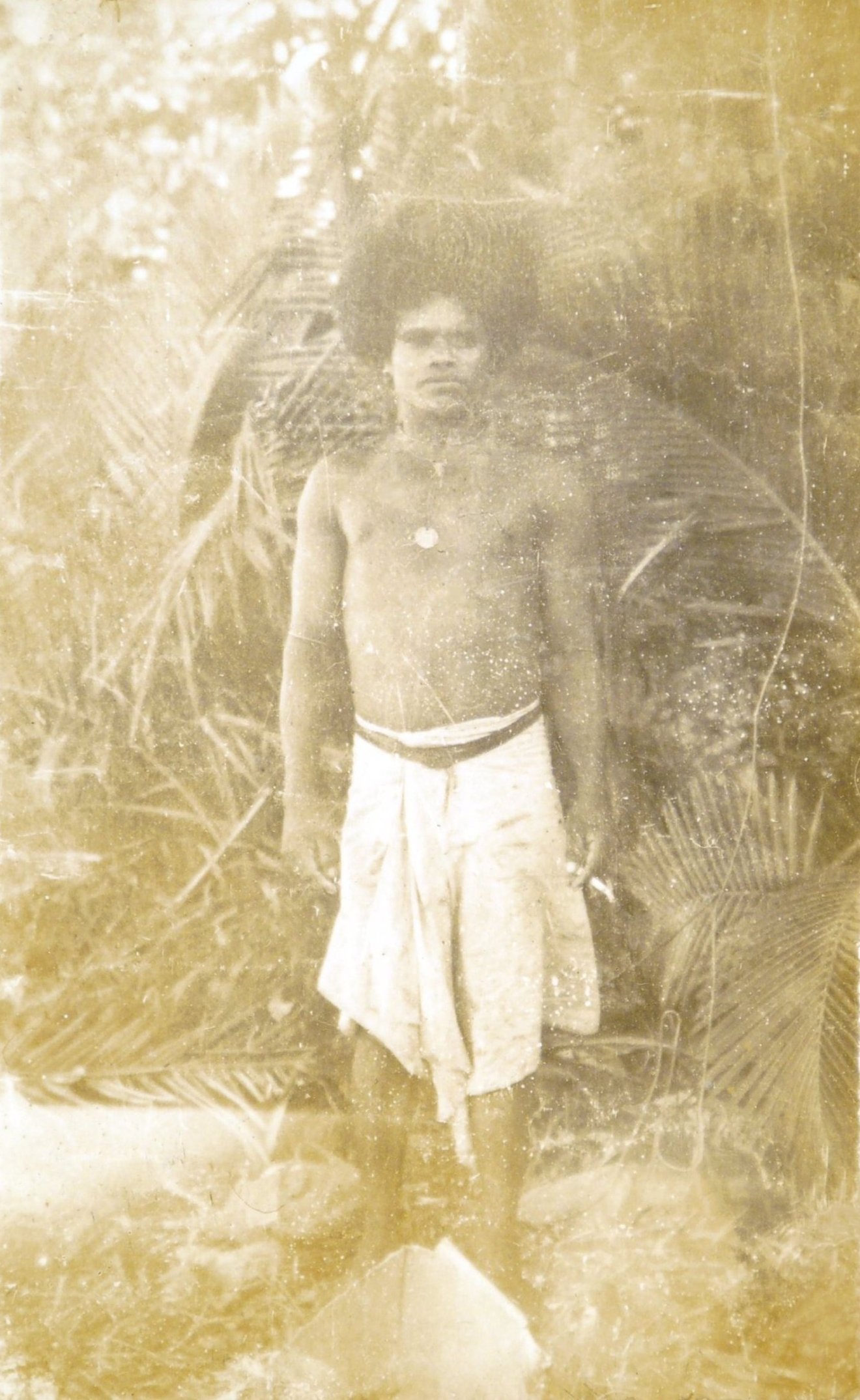
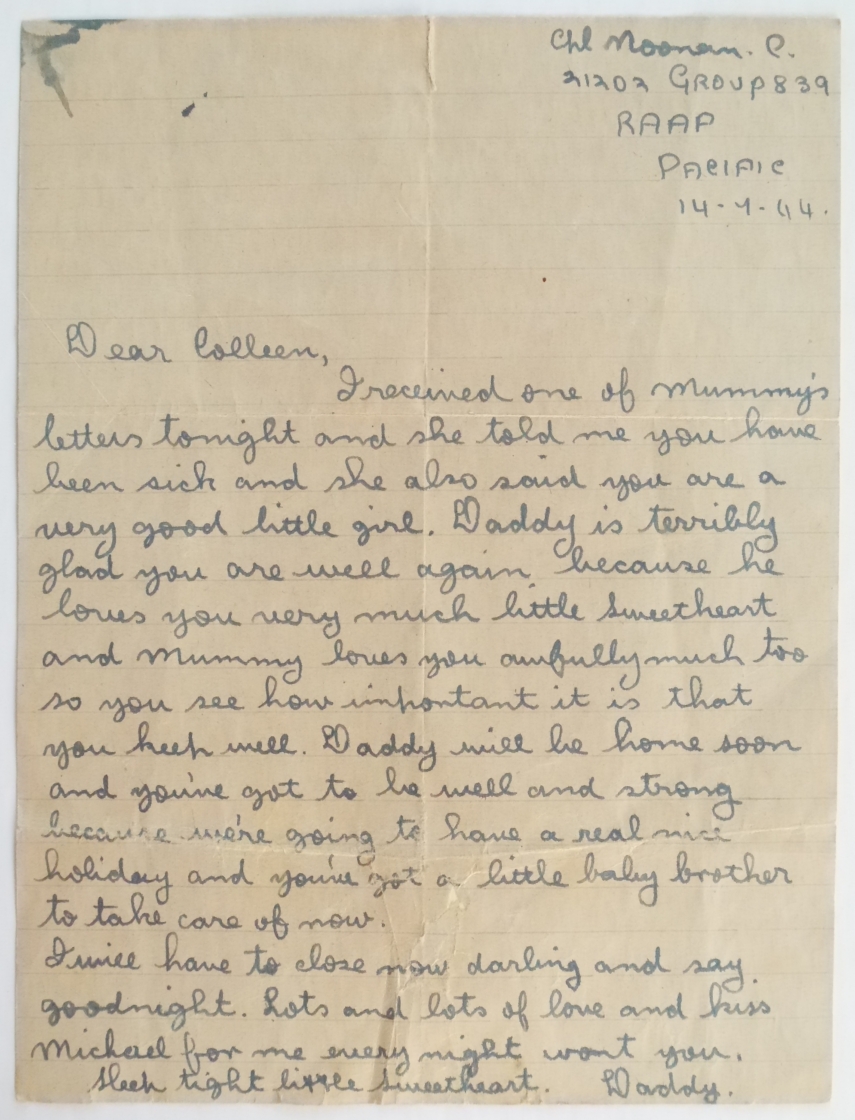


Thank you Clem for your effort to help preserve our liberty, freedom and decency and to you Paul for your effort to share Clem’s story with us. Lest We Forget. Kind regards, Graeme Palmer gpalmer@gil.com.au 0412982133